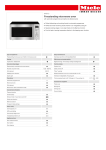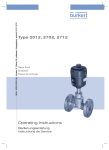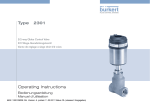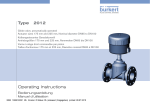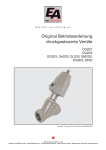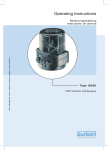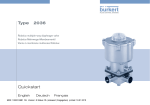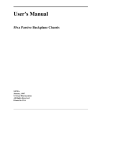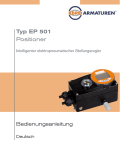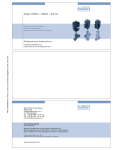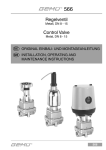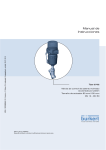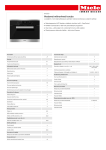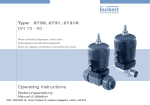Download Operating Instructions Type 2702
Transcript
Type2702 Piston actuated angle seat valve Kolbengesteuertes Schrägsitzventil Soupape de réglage à tête inclinée commandée par piston Operating Instructions Bedienungsanleitung Manuel d‘utilisation We reserve the right to make technical changes without notice. Technische Änderungen vorbehalten. Sous resérve de modification techniques. © 2005 - 2009 Bürkert Werke GmbH & Co. KG Operating Instructions 0906/03_EU-ML_00804367 Contents List of content Type Generales Notes.................................................................................................................................................. 5 Intended use..................................................................................................................................................................... 6 General safety notes....................................................................................................................................................... 6 Scope of delivery............................................................................................................................................................. 7 Warranty............................................................................................................................................................................. 7 Transport , storage........................................................................................................................................................... 7 Disposal............................................................................................................................................................................. 8 Information in internet..................................................................................................................................................... 8 Technical Data........................................................................................................................................................ 9 Construction of the control valve...............................................................................................................................10 Media................................................................................................................................................................................10 Kv values..........................................................................................................................................................................11 Commissioning..................................................................................................................................................... 13 Installation of the valve..................................................................................................................................................14 Procedure for TopControl Type 8630...........................................................................................................14 Procedure for SideControl Type 1067..........................................................................................................15 Pneumatic installation for TopControl Type 8630 ................................................................................................17 Fluid connections of the TopControl Continuous.......................................................................................17 Electrical connection - multipole connectors (TopControl Type 8630)............................................................18 Marking of the multipole plugs or sockets and the contacts....................................................................18 Output signals for SPS (circular plug M 16)...............................................................................................19 Operating voltage (circular plug M 12).........................................................................................................19 Inductive proximity switches (circular socket M8)......................................................................................19 Process value (circular plug M 8)...................................................................................................................20 2702 - 3 english Symbols............................................................................................................................................................................. 6 Contents Electrical connection - terminals for cable bushing (TopControl Type 8630)................................................21 Connection PCB of the TOPControl Continuous with screw terminals and jumpers.......................21 Terminal configuration with cable bushings.................................................................................................21 Choice of binary outputs or process value input........................................................................................22 english Setting the inductive proximity switches (option for TopControlTyp 8630)....................................................23 Opening the hosing of the TOPControl Continuous..................................................................................23 Positioning the inductive proximity switches................................................................................................23 Electrical connection - terminal for cable bushing (SideControl Type 1067).................................................24 Pin assignment....................................................................................................................................................24 Maintenance and servicing of the valve................................................................................... 25 Faults................................................................................................................................................................................26 Replacement of the control plug with TopControl Typ 8630..............................................................................26 Demounting the actuator..................................................................................................................................26 Replacement of the control plug.....................................................................................................................27 Mounting the actuator.......................................................................................................................................27 Replacement of the control plug wtih SideControl Typ 1067............................................................................28 Demounting the actuator..................................................................................................................................28 Replacement of the control plug.....................................................................................................................29 Mounting the actuator.......................................................................................................................................30 Spare parts sets type 2702........................................................................................................................................31 4 - 2702 General Notes General Notes Intended use............................................................................................................................................................. 6 General Safety Notes..................................................................................................................................... 6 Scope of delivery................................................................................................................................................ 7 Warranty...................................................................................................................................................................... 7 Transport, storage........................................................................................................................................... 7 Disposal........................................................................................................................................................................ 8 Information in internet................................................................................................................................. 8 2702 - 5 english Symbols......................................................................................................................................................................... 6 General Notes Symbols The following symbols are used in these operating instructions: marks a word step that you must carry out. english Danger! means an immediate danger. If it is not avoided, death or serious injury (maiming) will result. Warning! means a possibly dangerous situation. If it is not avoided, death or serious injury may result. Caution! means a possibly dangerous situation. If it is not avoided, light injury may result. May also be used for warnings regarding property damage. Attention! means a possibly damaging situation. If it is not avoided, the product or its surroundings may be damaged. Note marks important additional information, tips and recommendations. Intended use This device may only be used in combination with third-party devices and components recommended or approved by Bürkert. The proper function and safe operation of this product depends on professional transportation, professional storage, installation, and mounting, as well as on careful operation and maintenance. In order for the device to function perfectly and have a long service life, you must observe the information given in these operating instructions and comply with the operating conditions and the permissible data which is specified in the „Technical Data“ chapter of these instructions. On non-observances of these notes and unauthorized interference with the device, we will refuse all liability and the warranty on device and accessories will become void! The device is only to be used as a process regulation valve. Any other use is not considered the intended use. Bürkert is not responsible for any damages resulting from such use. The user bears all risk. General safety notes Danger! • Switch off the supply voltage in all cases before intervening in the system! • Note that in systems under pressure, piping and valves may not be loosened! Warning! 6 - 2702 • Observe the current regulations on accident prevention and safety during operation and maintenance of the device! General Notes Attention! • Keep to standard engineering rules in planning the use of and operating the device! • Installation and maintenance work are only allowed by specialist personnel using suitable tools! • Take suitable precautions to prevent inadvertent operation or damage by unauthorized action! • For the electrical part, observe the safety instructions in the operating manual of the TopControl, SideControls. • Failure to observe this operating manual and its operating instructions as well as unauthorized tampering with the device release us from any liability and also invalidate the warranty covering the devices and accessories! Scope of deliver Immediately after receipt of a shipment, make sure that the contents are undamaged and match thescope of delivery stated on the packing slip. If there are discrepancies, please contact immediately our customer service: Bürkert Fluid Control System Sales Center Chr.-Bürkert-Str. 13-17 D-76453 Ingelfingen Tel.: +49 (07940) 10 91-111 Fax: +49 (07940) 10 91 -448 E-mail: [email protected] or your local Bürkert distribution centre. Warranty This document contains no promise of guarantee. Please refer to our general terms of sales and delivery. The warranty is only valid if the device is used as intended in accordance with the specified application conditions. Attention! The warranty extends only to defects in the delivered Type 2702 valve with pneumatic drive and the TopControl or SideControl. We accept no liability for any kind of collateral damage which can occur due to failure or malfunction of the device. Transport, Storage Note Transportation and storage of the product should only be done in the original packing. Storage temperature -10 °C ... +60 °C 2702 - 7 english • Make sure that after an interruption to the electrical or pneumatic supply, the process starts up again ina well-defined, controlled manner! General Notes Disposal Caution! Environmental danger! When disponsing of the appliance, observe the national standards for refuse disposal. english Information IN Internet All Operating manuals and Datasheets for the Type 2702 you can find under: www.burkert.com - Technical data www.burkert.com → Documentation → Manuals → Typ 2702 You can order the complete operating manual using the following ID number: 804 625 8 - 2702 Technical data Construction of the control valve............................................................................................. 10 Media.............................................................................................................................................................................. 10 Kv value .................................................................................................................................................................... 11 2702 - 9 english Technical Data Technical Data Construction of the control valve 2/2-way piston actuated valve with control plug and angle seat body Control function A (closed by spring force) Normally close english Control function B (open in rest position) Normally open Actuator material: PA (polyamide) or PPS Body material: stainless steel 316L Seal materials: steel/steel (1.4571) or PTFE/steel Media Liquid and gaseous media that do not attack the body and seal materials. Control medium: Note instrument air, class 3 according DIN ISO 8573-1 The permitted operating pressure and temperature of the medium are listed on the rating plate and in the following tables. With regard to the permissible seat leakage, the values given in DIN EN 1349 are complied with,whereby for the steel/steel seal, leakage class IV and for the PTFE/steel leakage class VI apply. Pilot pressure Actuator size 80 (F) 5.5 - 10 bar Actuator size 100 (G) 5.5 - 7 bar Fluid pressure Actuator size F DN 13 / DN 15 0 - 16 bar Actuator size F DN 20 0 - 16 bar Actuator size F DN 25 0 - 16 bar Actuator size F DN 32 0 - 15 bar Actuator size G DN 40 0 - 12,5 bar Actuator size G DN 50 0 - 7,2 bar 10 - 2702 Technical Data Kv value Type 2702 DN 13 / DN 15 english Stroke % Stroke [mm] Kv [m3/h] 5 0.6 0.23 10 1.2 0.24 20 2.4 0.26 30 3.6 0.35 40 4.8 0.7 50 6.0 1.85 60 7.2 2.9 70 8.4 3.5 80 9.6 4.0 90 10.8 4.3 100 12.0 4.5 Stroke % Type 2702 DN 20 Stroke % Stroke [mm] Kv [m3/h] 5 0.9 0.30 10 1.8 0.33 20 3.6 0.42 30 5.4 0.7 40 7.2 2.85 50 9.0 5.3 60 10.8 6.6 70 12.6 7.5 80 14.4 8.2 90 16.2 8.6 100 18.0 9.0 Stroke % Type 2702 DN 25 Stroke % Stroke [mm] Kv [m3/h] 5 1.0 0.39 10 2.0 0.41 20 4.0 0.60 30 6.0 1.25 40 8.0 4.5 50 10.0 8.5 60 12.0 10.5 70 14.0 12.2 80 16.0 13.5 90 18.0 14.2 100 20.0 15.0 Stroke % 2702 - 11 Technical Data english Type 2702 DN 32 Stroke % Stroke [mm] Kv [m3/h] 5 1.0 0.55 10 2.0 0.65 20 4.0 0.95 30 6.0 1.5 40 8.0 4.0 50 10.0 9.3 60 12.0 13.8 70 14.0 16.5 80 16.0 18.8 90 18.0 21.0 100 20.0 23.0 Stroke % Type 2702 DN 40 Stroke % Stroke [mm] Kv [m3/h] 5 1.3 0.65 10 2.6 0.85 20 5.2 1.5 30 7.8 5.0 40 10.4 14.0 50 13.0 20.0 60 15.6 25.0 70 18.2 27.0 80 20.8 30.0 90 23.4 33.0 100 26.0 35.0 Stroke % Type 2702 DN 50 Stroke % Stroke [mm] Kv [m3/h] 5 1.3 1.0 10 2.6 1.3 20 5.2 2.0 30 7.8 5.0 40 10.4 16.0 50 13.0 27.0 60 15.6 34.0 70 18.2 41.0 80 20.8 45.0 90 23.4 49.0 100 26.0 53.0 Stroke % 12 - 2702 Commissioning Commissioning Installation of the valve.......................................................................................................................... 14 Procedure for TopControl Type 8630.......................................................................................................................14 PNEUMATIC INSTALLATION FOR TOPCONTROL TYPE 8630 ....................................................17 Fluid connections of the TopControl Continuous..................................................................................................17 Electrical connection - multipole connectors (TopControl Type 8630)................................................................................................................................ 18 Marking of the multipole plugs or sockets and the contacts...............................................................................18 Output signals for SPS (circular plug M 16)...........................................................................................................19 Operating voltage (circular plug M 12)....................................................................................................................19 Inductive proximity switches (circular socket M8)..................................................................................................19 Process value (circular plug M 8)..............................................................................................................................20 Electrical connection - terminals for cable bushing (TopControl Type 8630)................................................................................................................................ 21 Connection PCB of the TOPControl Continuous with screw terminals and jumpers...................................21 Terminal configuration with cable bushings.............................................................................................................21 Choice of binary outputs or process value input....................................................................................................22 Setting the inductive proximity switches (Option for TopControl Type 8630).................................................................................................. 23 Opening the housing of the TOPControl Continuous..........................................................................................23 Positioning the inductive proximity switches...........................................................................................................23 Electrical connection - terminal for cable bushing (SideControl Type 1067)............................................................................................................................... 24 Pin assignment...............................................................................................................................................................24 2702 - 13 english Procedure for SideControl Type 1067.....................................................................................................................15 Commissioning Installation of the valve Caution! Use of the incorrect lubricant causes contamination! For special applications such as for oxygen and analysis, use only the approved lubricants. May be installed in any position, but preferably with the actuator above. Observe the flow direction - general rule for control valves: flow direction: Below seat english Clean the piping of contamination! Before connecting the valve body, take care that piping is aligned! In the case of weld-end bodies, be sure to remove the actuator before welding. Procedure for TopControl Type 8630 TopControl 1. Remove the electrical and pneumatic supplies from the TopControl. 2. Pull off the pneumatic hose between TopControl and actuator at control connection of actuator. 3. Control function A: Pressurize the lower pilot air port of the actuator with compressed air (6 bar), so that the plug is lifted from the valve seat and is not damaged. Control function B: With control function B, no compressed air must beapplied for this purpose. 4. Remove the actuator in the open valve position by unscrewing the nipple from the valve body. 5. Before reinstalling the actuator (in the open valve position), grease the nipple thread with stainless steel lubricant, e. g. Klüberpaste UH1 96-402 from company Klüber. actuator lower pilot air port threaded nipple valve body 6. Replace the graphite seal. 7. After tightening the threaded nipple, align the pilot air ports by turning the actuator. Attention! Note 14 - 2702 The valve must be for this in the opened position. When using in an aggressive environment, you are advised to connect pneumatic hoses to all free control connections and place their other ends in a neutral atmosphere. Commissioning Procedure for SideControl Type 1067 Dismount the piston actuator as described below. You will avoid damage to the gaskets because the piston will be brought into the upper position. Connect compressed air at 4.5 to 6 bar to P (1). Remove the blowout mouthpiece. Unscrew the 4 screws. english Open the cover (2). The 2 red switches for emergency manual actuation (3) are located next to the terminal strip. They are in the idle position when the arrow is parallel to the terminal strip. Turn the 2 switches carefully 90 degrees in the clockwise direction (in either order) (4a). The piston moves into the upper position and the plug is separated from the valve seat. Turn only the upper switch to the idle position (4b). The piston stays in the upper position even after the compressed air is switched off. 2702 - 15 Commissioning Remove the valve body from the piston actuator. english The plug is now in the upper position. This means the gasket will not be damaged. Weld the valve body. Clean the valve body carefully. RECOMMENDATION Mount the valve body with a new sealing ring between the valve body and the piston actuator. plug Turn the lower switch back into the idle position. The piston actuator is bled and the spring closes the valve. Note 16 - 2702 This procedure causes air to be trapped under the spring-loaded piston. Normally the air will escape slowly. After 10 hours, however, this procedure should be completed. Commissioning PNEUMATIC INSTALLATION FOR TOPCONTROL TYPE 8630 The control valve is driven by compressed air via the TopControl. Remove the protective caps from the connectors on the TopControl and the valve. The supply pressure necessary for complete opening or closing of the valve may lie between the minimum values of 3 and 6 bar, depending on the actuator. The permissible maximum value for the control pressure is 7 bar. The values for the pressure supply are given under pPilot on the rating plate of each control valve. Attach the exhaust line or silencer to port ”3”. Control medium: instrument air, class 3 to DIN ISO 8573-1 Fluid connections of the TopControl Continuous Remove the protective caps from the valve and the TOPControl Continuous. Apply the supply pressure to connection “1“ (3..7 bar, instrument air, free from oil, water and dust) Attach the exhaust line or silencer to connection „3“ Note Maintain the applied supply pressure, without fail, at least 0.5 - 1 bar over that required to bring the pneumatic actuator into the end position. This assures that the control behaviour in the upper region of the stroke will not be significantly affected negatively if the pressure difference is too small. Keep variations in the supply pressure as low as possible during operation (max. ± 10%). With larger variations, the controller parameters calibrated with the AUTOTUNE function will not be optimal. 2702 - 17 english Apply the supply pressure to port ”1”. Commissioning Electrical connection - multipole connectors (TopControl Type 8630) Attention! english Note For connection to the technical earth (ground) (TE), a threaded stud with nut is provided on the connection module. To assure electromagnetic compatibility (EMC), connect this stud to a suitable earthing (grounding) point using as short a cable as possible (max. 30 cm). Use of the 4 - 20 mA setpoint input If the voltage supply of a TOPControl device fails in a row of such devices connected in series, the input of the failed device will become high-impedance. This will cause the 4 20 mA standard signal to fail. If this occurs, please contact Bürkert Service directly. With Profibus DP or DeviceNet: The markings of the multipole plugs and sockets, and the contacts are to be found in the respective chapters. Marking of the multipole plugs or sockets and the contacts M16 M12 M8 M8 Output signals to SPS Operating voltage TE Process value 18 - 2702 Initiators (inductive proximity switches) Commissioning Output signals for SPS (circular plug M 16) PIN Allocation External connection/signal level A Setpoint GND B B Setpoint + (0/4..20 mA or 0..5/10 V) C Analog position feedback + C D Analog position feedback GND D + (0/4...20 mA or 0...5/10 V) completely isolated electrically GND E Binary output 1 E 24 V / 0 V F Binary output 2 F 24 V / 0 V G Binary output GND G 24 V / 0 V H Binary input + H J Binary input GND J + GND K not connected L not connected M not connected A english + (0/4...20 mA or 0..5/10 V) completely isolated electrically GND 0 ... 5 V (log. 0) 10 ... 30 V (log. 1) Operating voltage (circular plug M 12) PIN Allocation 1 + 24 V 2 not connected 3 GND 4 not connected External connection 1 24 V DC ± 10 % max. residual ripple 10 % 3 Inductive proximity switches (circular socket M8) PIN Allocation Signal level 1 Proximity switch 1 +(NO) +24 V DC 2 Proximity switch 1 GND 3 Proximity switch 2 +(NO) +24 V DC 4 Proximity switch 2 GND GND S1 1 2 GND S2 3 4 open / 24 V GND open / 24 V GND 2702 - 19 Commissioning english Process value (circular plug M 8) Input type * PIN Allocation Jumper ** External connection 4 ... 20 mA - internal supply 1 2 3 4 + 24 V supply transmitter Output transmitter GND bridge to GND 4 ... 20 mA - external supply 1 2 3 4 not connected Process actual + not connected Process actual - 2 4 ... 20 mA 4 GND Frequency - internal supply 1 2 3 4 + 24 V - supply sensor Clock input + Clock input - (GND) not connected 1 +24 V 2 Clock + 3 Clock - Frequency - external supply 1 2 3 4 not connected Clock input + Clock input not connected 2 Clock + 3 Clock - Pt-100 (see note below) 1 2 3 4 not connected process actual 1 (current supply) process actual 3 (GND) process actual 2 (compensation) 2 3 Pt 100 4 * May be set via software (section Procedure for specifying the basic settings) ** The jumper is situated on the connection board of the TOPControl Continuous (see next page) Note 20 - 2702 For line compensation reasons, connect sensor Pt-100 via 3 conductors. PIN 3 and PIN 4 must be bridged at the sensor. Commissioning Electrical connection - terminals for cable bushing (TopControl Type 8630) Note For connection to the technical earth (ground) (TE), a threaded stud with nut is provided on the connection module. To assure electromagnetic compatibility (EMC), connect this stud to a suitable earthing (grounding) point using as short a cable as possible (max. 30 cm). Use of the 4 - 20 mA setpoint input If the voltage supply of a TOPControl Continuous device fails in a row of such devices connected in series, the input of the failed device will become high-impedance. This will cause the 4 - 20 mA standard signal to fail. If this occurs, please contact Bürkert Service directly. Connection PCB of the TOPControl Continuous with screw terminals and jumpers Remove the cover with the cable bushings to gain access to the screw terminals. This is done by unscrewing the 4 self-tapping screws. Terminal configuration with cable bushings Terminal Allocation External connection 1 2 Setpoint + Setpoint GND 1 + (0/4 ... 20 mA or 0 ... 5/10 V) 2 GND 3 Analog position feedback + 3 4 Analog position feedback GND 4 + (0/4 ... 20 mA or 0 ... 5/10 V) completely isolated electrically GND 5 6 Operating voltage + Operating voltage GND 5 24 V DC ± 10 % max. residual ripple 10 % 6 2702 - 21 english Attention! Commissioning Choice of binary outputs or process value input Select using the jumpers: 2 binary outputs (see terminal Allocation when binary outputs selected) or Process value input (see terminal Allocation when process value input selected) Terminals 7 to 10 are connected to the corresponding signals. english Terminal allocation on selection of binary outputs Jumper Terminal Allocation External connection 7 8 Binary output 1 Binary output 1 7 8 24 V / 0 V 9 10 Binary output 2 Binary output 2 9 10 24 V / 0 V NC / NO GND NC / NO GND Terminal allocation on selection of process value input: The input type is set via the configuration menu (see Procedure for specifying the basic settings). Input type* Jumper Termianl Allocation 4 ... 20 mA internal supply External connection 7 8 9 10 + 24 V input transmitter Output transmitter Brigde to GND GND Frequency internal supply 7 8 9 10 + 24 V supply sensor Clock input + not connected Clock input - (GND) 4 ... 20 mA external supply 7 8 9 10 not connected Process actual + Process actual not connected Frequency external supply 7 8 9 10 not connected Clock input + not connected Clock input - Pt-100 (see note below) 7 8 9 10 not connected Process actual 1 (current supply) Process actual 2 (compensation) Process actual 3 (GND) Note 7 8 9 10 7 8 9 +24 V Clock + Clock - (GND) 8 9 + (4 ... 20 mA) Clock - (GND) 8 10 Clock + Clock - (GND) 8 9 10 Pt-100 For reasons of line compensation, connect the Pt 100 sensor over 3 conductors. Be sure to bridge terminals 9 and 10 at the sensor. Terminal allocation with binary outputs Terminal Allocation 11 12 22 - 2702 Binary input + Binary input GND External connection 11 12 + GND 0 ... 5 V (log. 0) 10 ... 30 V (log. 1) Commissioning Setting the inductive proximity switches (Option for TopControl Type 8630) Caution! Danger of injury from electrical voltage in the open TopControl. Switch the operating power off to the TopControl before opening! english Opening the housing of the TOPControl Continuous Remove any lead seals or fastenings present between cover and housing. Turn the cover anticlockwise and lift it off. Positioning the inductive proximity switches The inductive proximity switches are positioned vertically with one adjusting screw each: Turning clockwise causes upward adjustment Turning anticlockwise causes downward adjustment Caution! Plug connectors may be damaged or loosened. Caution! Plug connectors may be damaged or loosened. On adjusting the height of the inductive proximity switches, make sure that adjacent flexes are not pulled (e.g. by getting hooked in the proximity switches). Screw to adjust the lower proximity switch Screw to adjust the upper proximity switch 2702 - 23 Commissioning Electrical connection - terminal for cable bushing (SideControl Type 1067) Pin assignment Signal input - either for target position (operation as positional control) english Jumper position - or for process target value (operation as process controller) - input for actual process value Binary input Contact Output (Option) Suppply voltage Input U1 (Unit signal 0 ... 10 V) Input impedance 200 kW Input I1 (Unit signal 0/4 ... 20 mA) Input impedance > 175 W Input I2 (Unit signal 4 ... 20 mA) Input impedance > 175 W Attention! To ensure electromagnetic compatibility (EMC resistance), the interior M4 threading of the armature must be connected to ground with the shortest possible cable. M4-internal thread 24 - 2702 Maintenance and Servicing of the valve Faults........................................................................................................................................................................... 26 Replacement of the plug with TopControl Type 8630................................................... 26 Demounting the actuator..............................................................................................................................................26 Replacement of the plug..............................................................................................................................................27 Mounting the actuator...................................................................................................................................................27 Replacement of the plug with SideControl Type 1067................................................. 28 Demounting the actuator..............................................................................................................................................28 Replacement of the plug..............................................................................................................................................29 Mounting the actuator...................................................................................................................................................30 Spare parts sets Type 2702...................................................................................................................... 31 2702 - 25 english Maintenance and servicing of the valve Maintenance and Servicing of the valve Faults Possible problems with control are listed in the operating manual of the TopControl. Attention! Repairs to the actuator may only be carried out in the factory. Contact your Bürkert branch or ourCustomer Service directly: english Bürkert Fluid Control System Sales Center Chr.-Bürkert-Str. 13-17 D-76453 Ingelfingen Tel.: +49 (07940) 10 91-111 Fax: +49 (07940) 10 91-448 E-Mail: [email protected] Replacement of the plug with TopControl Type 8630 Caution! Use of the incorrect lubricant causes contamination! For special applications such as for oxygen and analysis, use only the approved lubricants. On the fluidic side is it possible to exchange the plug if it becomes worn or damaged. For this purpose the actuator must be disassembled from the valve body. Demounting the actuator → Remove the electrical and pneumatic supplies from the TopControl. → Pull off the pneumatic hose between TopControl and actuator at control connection of actuator Control function A: → Pressurize the lower pilot air of the actuator with compressed air (6 bar), so that the plug is lifted from the valve seat and is not damaged. Control function B: → With control function B, no compressed air must be applied for this purpose. → Remove the actuator in the open valve position by unscrewing the nipple from the valve body. 26 - 2702 threaded nipple Maintenance and Servicing of the valve Replacement of the plug Attention! Do not damage the sealing surface or the control contour! → Knock out the dowel pin with a suitable driver. Driver diameter: up to DN 32 ∅ 4 mm from DN 40 ∅ 5 mm english → Pull off the plug with aid of two metal strips of equal height that are clamped to the left and right of the spindle between the plug and the threaded nipple of the actuator. To pull off the plug, apply compressed air (approx. 6 bar) to the lower pilot air port of the actuator. → Push the new plug over the end of the spindle. → Align the bores. Dowel pin Plug Mounting the actuator → Support the plug at its cylindrical part with the aid of a V-block or the like. → Carefully knock the dowel pin into the bore with a hammer. → Bring the dowel pin into a central position relative to the spindle axis (knock in as far as the end of the recess). → Before reinstalling the actuator, grease the nipple thread with stainless steel lubricant, e.g.Klüberpaste UH1 96-402 from company Klüber and replace the graphite seal.* → After tightening the threaded nipple, orient the control connection by turning the actuator.* Attention! * The valve must be for this in the opened position. 2702 - 27 Maintenance and Servicing of the valve Replacement of the plug with SideControl Type 1067 Caution! Use of the incorrect lubricant causes contamination! For special applications such as for oxygen and analysis, use only the approved lubricants. english Demounting the actuator Dismount the piston actuator as described below. You will avoid damage to the gaskets because the piston will be brought into the upper position. Connect compressed air at 4.5 to 6 bar to P (1). Remove the blowout mouthpiece. Unscrew the 4 screws. Open the cover (2). The 2 red switches for emergency manual actuation (3) are located next to the terminal strip. They are in the idle position when the arrow is parallel to the terminal strip. Turn the 2 switches carefully 90 degrees in the clockwise direction (in either order) (4a). The piston moves into the upper position and the plug is separated from the valve seat. Turn only the upper switch to the idle position (4b). The piston stays in the upper position even after the compressed air is switched off. 28 - 2702 Maintenance and Servicing of the valve Remove the valve body from the piston actuator. english The plug is now in the upper position. This means the gasket will not be damaged. Weld the valve body. Plug Replacement of the plug Attention! Do not damage the sealing surface or the control contour at the plug! → Knock out the dowel pin with a suitable driver. Driver diameter: up to DN 32 ∅ 4 mm from DN 40 ∅ 5 mm → Pull off the plug with aid of two metal strips of equal height that are clamped to the left and right of the spindle between the plug and the threaded nipple of the actuator. To pull off the plug, apply compressed air (approx. 6 bar) to the lower pilot air port of the actuator. → Push the new plug over the end of the spindle. → Align the bores. Dowel pin Plug 2702 - 29 Maintenance and Servicing of the valve Mounting the actuator english Mount the valve body with a new sealing ring between the valve body and the piston actuator. plug Turn the lower switch back into the idle position. The piston actuator is bled and the spring closes the valve. Note 30 - 2702 This procedure causes air to be trapped under the spring-loaded piston. Normally the air will escape slowly. After 10 hours, however, this procedure should be completed. Maintenance and Servicing of the valve Spare part sets for Type 2702 standard version english Angle seat control valve Plug set Warning! Danger due to spraying of fluids under high pressure! Always interrupt the medium flow before disassembling or opening the device, and let off the pressure in the hose system. Plug set 6 DN PTFE - steel Order no. steel - steel Order no. 13 / 15 170315 170322 20 170316 170323 25 170318 170324 32 170319 170325 40 170320 170326 50 170321 170327 Contains: Plug, dowel pin, graphite seal, lubricant 2702 - 31 Maintenance and Servicing of the valve english Note 32 - 2702 Spare parts sets for special versions are available on request (e.g. oxygen or analysis versions, etc.). Inhalt Inhaltsverzeichnis Typ 2702 Allgemeine Hinweise....................................................................................................................................... 35 Darstellungsmittel..........................................................................................................................................................36 Bestimmungsgemäßer Gebrauch..............................................................................................................................36 Lieferumfang...................................................................................................................................................................37 Gewährleistung..............................................................................................................................................................37 Transport und Lagerung...............................................................................................................................................37 Entsorgung......................................................................................................................................................................38 Informationen im Internet..............................................................................................................................................38 Technische Daten............................................................................................................................................. 39 Aufbau des Regelventils...............................................................................................................................................40 Medien..............................................................................................................................................................................40 Kv-Werte ........................................................................................................................................................................41 Inbetriebnahme................................................................................................................................................... 43 Einbau des Ventils.........................................................................................................................................................44 Vorgehensweise bei TopConrol Typ 8630...................................................................................................44 Vorgehensweise bei SideControl Typ 1067................................................................................................45 Pneumatische Installation bei TopControl Typ 8630 . .........................................................................................47 Fluidische Anschlüsse des TopControl Continuous.................................................................................47 Elektrischer Anschluss - Multipolstecker (TopControl Typ 8630).....................................................................48 Bezeichnung der Multipolstecker bzw. -buchsen und der Kontakte......................................................48 Ausgangssignale zur SPS ( Rundstecker M 16).........................................................................................49 Betriebsspannung (Rundstecker M 12)........................................................................................................49 Induktive Näherungsschalter (Buchse rund M 8)........................................................................................49 Prozess-Istwert (Rundstecker M 8)................................................................................................................50 2702 - 33 deutsch Allgemeine Sicherheitshinweise.................................................................................................................................36 Inhalt Elektrischer Anschluss - Klemmen für Kabelverschraubung (TopControl Typ 8630)...................................51 Anschlussplatine des TOP Control Continuous mit Schraubklemmen und Jumpern........................51 Klemmenbelegung bei Kabelverschraubung................................................................................................51 Auswahl zwischen binären Ausgängen und Prozess-Istwert-Eingang..................................................52 Einstellen der induktiven Näherungsschalter (Option bei TopControlTyp 8630)...........................................53 Öffnen des TOP Control Continuous-Gehäuses........................................................................................53 Positionieren der induktiven Näherungsschalter.........................................................................................53 deutsch Elektrischer Anschluss - Klemmen für Kabelverschraubung (SideControl Typ 1067).................................54 Anschlussbelegung............................................................................................................................................54 Instandhaltung und Wartung des Ventils.............................................................................. 55 Störungen........................................................................................................................................................................56 Austausch des Regelkegels bei TopControl Typ 8630........................................................................................56 Demontage des Antriebs..................................................................................................................................56 Austausch des Regelkegels.............................................................................................................................57 Montage des Antriebs.......................................................................................................................................57 Austausch des Regelkegels bei SideControl Typ 1067......................................................................................58 Demontage des Antriebs..................................................................................................................................58 Austausch des Regelkegels.............................................................................................................................59 Montage des Antriebs.......................................................................................................................................60 Ersatzteilsätze für Standardgeräte Typ 2702..........................................................................................................61 34 - 2702 Allgemeine Hinweise Allgemeine Hinweise Darstellungsmittel....................................................................................................................................... 36 Allgemeine Sicherheitshinweise........................................................................................................ 36 Lieferumfang......................................................................................................................................................... 37 Gewährleistung................................................................................................................................................. 37 Transport und Lagerung.......................................................................................................................... 37 Entsorgung........................................................................................................................................................... 38 Informationen im Internet....................................................................................................................... 38 2702 - 35 deutsch BestimmungsgemäSSer Gebrauch................................................................................................... 36 Allgemeine Hinweise Darstellungsmittel In dieser Betriebsanleitung werden folgende Darstellungsmittel verwendet: markiert einen Arbeitsschritt, den Sie ausführen müssen Gefahr! Warnung! deutsch Vorsicht! Achtung! Hinweis bezeichnet eine unmittelbare drohende Gefahr. Wenn sie nicht gemieden wird, sind Tod oder schwerste Verletzungen (Verkrüppelung) die Folge. bezeichnet eine möglicherweise gefährliche Situation. Wenn sie nicht gemieden wird, können Tod oder schwerste Verletzungen die Folge sein. bezeichnet eine möglicherweise gefährliche Situation. Wenn sie nicht gemieden wird, können leichte oder geringfügige Verletzungen die Folge sein. Darf auch für Warnungen vor Sachschäden verwendet werden. bezeichnet eine möglicherweise schädliche Situation. Wenn sie nicht gemieden wird, kann das Produkt oder etwas in seiner Umgebung beschädigt werden. bezeichnet wichtige Zusatzinformationen, Tipps und Empfehlungen BestimmungsgemäSSer Gebrauch Das Gerät darf nur in Verbindung mit von Bürkert empfohlenen bzw. zugelassenen Fremdgeräten und –komponenten verwendet werden. Der einwandfreie und sichere Betrieb des Produktes setzt sachgemäßen Transport, sachgemäße Lagerung, Aufstellung und Montage sowie sorgfältige Bedienung und Instandhaltung voraus. Bitte beachten Sie die Hinweise dieser Anleitung sowie die Einsatzbedingungen und zulässigen Daten, die im Kapitel "Technische Daten" spezifiziert sind, damit das Gerät einwandfrei funktioniert und lange einsatzfähig bleibt. Bei Nichtbeachtung dieser Hinweise sowie bei unzulässigen Eingriffen in das Gerät entfällt jegliche Haftung unsererseits, ebenso erlischt die Garantie auf Geräte u. Zubehörteile! Das Gerät dient ausschließlich als Prozessregelventil. Eine andere oder darüber hinausgehende Benutzung gilt als nicht bestimmungsgemäß. Für hieraus resultierende Schäden haftet Bürkert nicht. Das Risiko trägt allein der Anwender. Allgemeine Sicherheitshinweise Gefahr! • Schalten Sie vor Eingriffen in das System in jedem Fall die Spannung ab! • Beachten Sie, dass in Systemen, die unter Druck stehen, Leitungen und Ventile nicht gelöst werden dürfen! Warnung! 36 - 2702 • Beachten Sie die geltenden Unfallverhütungs- und Sicherheitsbestimmungen während des Betriebs, der Wartung und der Reparatur des Gerätes! Allgemeine Hinweise Achtung! • Halten Sie sich bei der Einsatzplanung und dem Betrieb des Gerätes an die allgemeinen Regeln der Technik! • Installation und Wartungsarbeiten dürfen nur durch Fachpersonal und mit geeignetem Werkzeug erfolgen! • Treffen Sie geeignete Maßnahmen, um unbeabsichtigtes Betätigen oder unzulässige Beeinträchtigung auszuschließen! • Gewährleisten Sie nach einer Unterbrechung der elektrischen oder pneumatischen Versorgung einen definierten und kontrollierten Wiederanlauf des Prozesses! • Beachten Sie zum elektrischen Teil die Sicherheitshinweise in der Bedienungsanleitung des TopControl, SideControl. Lieferumfang Überzeugen Sie sich unmittelbar nach Erhalt der Sendung, dass der Inhalt nicht beschädigt ist und mit dem auf dem beigelegten Lieferschein angegebenen Lieferumfang übereinstimmt. Bei Unstimmigkeiten wenden Sie sich bitte umgehend an unseren Kundenservice: Bürkert Fluid Control System Sales Center Chr.-Bürkert-Str. 13-17 D-76453 Ingelfingen Tel.: +49 (07940) 10 91-111 Fax: +49 (07940) 10 91-448 E-mail: [email protected] oder an Ihr Bürkert Vertriebs-Center. Gewährleistung Diese Druckschrift enthält keine Garantiezusagen. Wir verweisen hierzu auf unsere allgemeinen Verkaufs- und Lieferbedingungen. Voraussetzung für die Gewährleistung ist der bestimmungsgemäße Gebrauch des Gerätes unter Beachtung der spezifizierten Einsatzbedingungen. Achtung! Die Gewährleistung erstreckt sich nur auf die Fehlerfreiheit des gelieferten Ventils Typ 2702 mit pneumatischem Antrieb und des TopControl oder SideControl. Für Folgeschäden jeglicher Art, die durch Ausfall oder Fehlfunktion des Gerätes entstehen könnten, wird keine Haftung übernommen. Transport und Lagerung HINWEIS Transportieren und lagern Sie das Gerät nur in der Originalverpackung. Lagertemperatur -10 °C ... +60 °C 2702 - 37 deutsch • Bei Nichtbeachtung dieser Bedinungsanleitung und ihrer Hinweise sowie bei unzulässigen Eingriffen in das Gerät entfällt jegliche Haftung unsererseits, ebenso erlischt die Garantie auf Geräte und Zubehörteile! Allgemeine Hinweise Entsorgung Vorsicht! Gefahr für die Umwelt! Beachten Sie bei der Entsorgung des Gerätes die nationalen Abfallbeseitigungsvorschriften. Informationen im Internet Bedienungsanleitungen und Datenblätter zum Typ 2702 finden Sie im Internet unter: deutsch www.buerkert.com → Dokumentation → Betriebsanleitungen → Typ 2702 Darüber hinaus steht eine komplette Dokumentation auf CD bereit. Die komplette Bedienungsanleitung können sie unter folgender Identnummer bestellen: 804 625 38 - 2702 Technische Daten Technische Daten Medien.......................................................................................................................................................................... 40 Kv-Werte ................................................................................................................................................................... 41 2702 - 39 deutsch Aufbau des Regelventils........................................................................................................................... 40 Technische Daten Aufbau des Regelventils 2/2-Wege-Kolbensteuerventil mit Regelkegel und Schrägsitzgehäuse Steuerfunktion A (in Ruhestellung durch Federkraft geschlossen) deutsch Steuerfunktion B (in Ruhestellung geöffnet) Antriebswerkstoff: PA (Polyamid) oder PPS Gehäusewerkstoff: Edelstahl 316L Dichtwerkstoffe: Stahl/Stahl (1.4571) oder PTFE/Stahl Medien Flüssige u. gasförmige Medien, die den Gehäuse- und Dichtwerkstoff nicht angreifen. Steuermedium:Instrumentenluft, Klasse 3 nach DIN ISO 8573-1 HINWEIS Den zugelassenen Betriebsdruck und die Mediumstemperatur entnehmen Sie dem Typschild und den folgenden Tabellen. Hinsichtlich der zulässigen Sitzleckage werden die in der DIN EN 1349 angegebenen Werte eingehalten, wobei für die Stahl/Stahl-Abdichtung die Leckageklasse IV und für die PTFE/Stahl-Adichtung die Leckageklasse VI zutrifft. Steuerdruck Antriebsgröße 80 (F) 5,5 - 10 bar Antriebsgröße 100 (G) 5,5 - 7 bar Mediumsdruck Antriebsgröße F DN 13 / DN 15 0 - 16 bar Antriebsgröße F DN 20 0 - 16 bar Antriebsgröße F DN 25 0 - 16 bar Antriebsgröße F DN 32 0 - 15 bar Antriebsgröße G DN 40 0 - 12,5 bar Antriebsgröße G DN 50 0 - 7,2 bar 40 - 2702 Technische Daten Kv-Werte Typ 2702 DN 13 / DN 15 Hub [mm] 0,6 1,2 2,4 3,6 4,8 6,0 7,2 8,4 9,6 10,8 12,0 Kv [m3/h] 0,23 0,24 0,26 0,35 0,7 1,85 2,9 3,5 4,0 4,3 4,5 deutsch Hub % 5 10 20 30 40 50 60 70 80 90 100 Hub % Typ 2702 DN 20 Hub % 5 10 20 30 40 50 60 70 80 90 100 Hub [mm] 0,9 1,8 3,6 5,4 7,2 9,0 10,8 12,6 14,4 16,2 18,0 Kv [m3/h] 0,30 0,33 0,42 0,7 2,85 5,3 6,6 7,5 8,2 8,6 9,0 Hub % Typ 2702 DN 25 Hub % 5 10 20 30 40 50 60 70 80 90 100 Hub [mm] 1,0 2,0 4,0 6,0 8,0 10,0 12,0 14,0 16,0 18,0 20,0 Kv [m3/h] 0,39 0,41 0,60 1,25 4,5 8,5 10,5 12,2 13,5 14,2 15,0 Hub % 2702 - 41 Technische Daten deutsch Typ 2702 DN 32 Hub % 5 10 20 30 40 50 60 70 80 90 100 Hub [mm] 1,0 2,0 4,0 6,0 8,0 10,0 12,0 14,0 16,0 18,0 20,0 Kv [m3/h] 0,55 0,65 0,95 1,5 4,0 9,3 13,8 16,5 18,8 21,0 23,0 Hub % Typ 2702 DN 40 Hub % 5 10 20 30 40 50 60 70 80 90 100 Hub [mm] 1,3 2,6 5,2 7,8 10,4 13,0 15,6 18,2 20,8 23,4 26,0 Kv [m3/h] 0,65 0,85 1,5 5,0 14,0 20,0 25,0 27,0 30,0 33,0 35,0 Hub % Typ 2702 DN 50 Hub % 5 10 20 30 40 50 60 70 80 90 100 Hub [mm] 1,3 2,6 5,2 7,8 10,4 13,0 15,6 18,2 20,8 23,4 26,0 Kv [m3/h] 1,0 1,3 2,0 5,0 16,0 27,0 34,0 41,0 45,0 49,0 53,0 Hub % 42 - 2702 Inbetriebnahme Inbetriebnahme Einbau des Ventils........................................................................................................................................... 44 Vorgehensweise bei TopConrol Typ 8630..............................................................................................................44 Vorgehensweise bei SideControl Typ 1067...........................................................................................................45 Pneumatische Installation bei TopControl Typ 8630 ...............................................47 Elektrischer Anschluss - Multipolstecker (TopControl Typ 8630)................ 48 Bezeichnung der Multipolstecker bzw. -buchsen und der Kontakte..................................................................48 Ausgangssignale zur SPS ( Rundstecker M 16)....................................................................................................49 Betriebsspannung (Rundstecker M 12)...................................................................................................................49 Induktive Näherungsschalter (Buchse rund M 8)...................................................................................................49 Prozess-Istwert (Rundstecker M 8)...........................................................................................................................50 Elektrischer Anschluss - Klemmen für Kabelverschraubung (TopControl Typ 8630)................................................................................................................................... 51 Anschlussplatine des TOPControl Continuous mit Schraubklemmen und Jumpern.....................................51 Klemmenbelegung bei Kabelverschraubung...........................................................................................................51 Auswahl zwischen binären Ausgängen und Prozess-Istwert-Eingang.............................................................52 Einstellen der induktiven Näherungsschalter (Option bei TopControlTyp 8630)........................................................................................................ 53 Öffnen des TOP Control Continuous-Gehäuses...................................................................................................53 Positionieren der induktiven Näherungsschalter....................................................................................................53 Elektrischer Anschluss - Klemmen für Kabelverschraubung (SideControl Typ 1067).................................................................................................................................. 54 Anschlussbelegung.......................................................................................................................................................54 2702 - 43 deutsch Fluidische Anschlüsse des TopControl Continuous............................................................................................47 Inbetriebnahme Einbau des Ventils Vorsicht! Falscher Schmierstoff verursacht Verunreinigungen! Verwenden Sie bei spezifischen Anwendungen, z.B. Sauerstoff- oder Analyseanwendungen nur zugelassene Schmierstoffe. Einbaulage beliebig, bevorzugt Antrieb nach oben. Beachten Sie die Durchflußrichtung! Bei Regelventilen gilt generell: Anströmung unter Sitz! Säubern Sie die Rohrleitungen von Verunreinigungen! Achten Sie vor Anschluß des Ventilgehäuses auf fluchtende Rohrleitungen! deutsch Entfernen Sie bei Schweißgehäusen den Antrieb unbedingt vor dem Einschweißen des Gehäuses. Vorgehensweise bei TopControl Typ 8630 TopControl 1. Entfernen Sie die elektrische u. pneumatische Versorgung vom TopControl. 2. Ziehen Sie den Pneumatikschlauch zwischen TopControl Antrieb unterer Steueranschluss und Antrieb am Steueranschluß des Antriebes ab. 3. Steuerfunktion A: Beaufschlagen Sie den unteren Steueranschluß des Antriebes mit Druckluft (6 bar), damit der Regelkegel vom Ventil- sitz abhebt und nicht beschädigt wird. Steuerfunktion B: Bei Steuerfunktion B muss keine Druckluft angelegt werden. 4. Entfernen Sie den Antrieb in offener Ventilstellung durch Los- schrauben des Nippels vom Gehäuse. GewindeNippel Gehäuse 5. Fetten Sie vor Wiedereinbau des Antriebes (in offener Ventil- stellung) das Nippelgewinde mit Edelstahlschmierstoff ein, z.B. Klüberpaste UH1 96 - 402 der Firma Klüber. 6. Erneuern Sie die Graphitdichtung. 7. Richten Sie nach Festziehen des Gewindenippels die Steueranschlüsse durch Verdrehen des Antriebes aus. ACHTUNG! HINWEIS 44 - 2702 Das Ventil muss sich in der geöffneten Stellung befinden. Bei Einsatz in aggressiver Umgebung empfehlen wir, sämtliche freien Pneumatikanschlüsse mit Hilfe eines Pneumatikschlauches in neutrale Atmosphäre abzuleiten. Inbetriebnahme Vorgehensweise bei SideControl Typ 1067 Demontieren Sie den Kolbenantrieb wie nachfolgend beschrieben. Sie vermeiden Schäden an den Dichtflächen, weil der Kolben in die obere Stellung gebracht wird. Schließen Sie Druckluft 4,5 bis 6 bar an P an (1). Nehmen Sie das Ausblasemundstück heraus. Drehen Sie die 4 Schrauben heraus. Die 2 roten Schalter für die Handnotbetätigung (3) befinden sich neben der Klemmenleiste. Sie sind in der Ruhelage, wenn der Pfeil parallell zur Klemmenleiste liegt. Drehen Sie die 2 Schalter vorsichtig im Uhrzeigersinn um 90 Grad (Reihenfolge beliebig) (4a). Der Kolben bewegt sich daraufhin in die obere Lage und der Regelkegel wird vom Ventilsitz getrennt. Drehen Sie nur den oberen Schalter bis zur Ruhelage (4b). Der Kolben bleibt in der oberen Lage, auch wenn die Druckluft abgeschaltet wird. 2702 - 45 deutsch Öffnen Sie den Deckel (2). Inbetriebnahme Trennen Sie das Ventilgehäuse vom Kolbenantrieb. deutsch Der Regelkegel befindet sich nun in der oberen Lage. Dadurch wird die Dichtungsfläche nicht beschädigt. Schweißen Sie das Ventilgehäuse Reinigen Sie das Ventilgehäuse sorgfältig. EMPFEHLUNG Montieren Sie das Ventilgehäuse mit einem neuen Dichtungsring zwischen Ventilgehäuse und Kolbenantrieb. Regelkegel Drehen Sie den unteren Schalter in die Ruhelage zurück. Der Kolbenantrieb wird entlüftet und die Feder schliesst das Ventil. HINWEIS 46 - 2702 Durch diese Vorgehensweise wird Luft unter dem federbelasteten Kolben eingeschlossen. Normalerweise entweicht die Luft langsam. Nach 10 Stunden sollte dieser Vorgang jedoch abgeschlossen sein. Inbetriebnahme Pneumatische Installation bei TopControl Typ 8630 Das Regelventil wird über das TopControl mit Druckluft angesteuert. Entfernen Sie die Schutzkappen von den Anschlüssen am TopControl und am Ventil Legen Sie den Versorgungsdruck an Anschluss ”1” Der für das vollständige Öffnen bzw. Schließen des Ventils erforderliche Versorgungsdruck kann je nach Antrieb, zwischen den Minimalwerten von 3 bar bis 6 bar liegen. Der zulässige Maximalwert für den Steuerdruck beträgt 7 bar. Die Werte für die Druckversorgung sind unter pPilot auf dem Typschild des jeweiligen Regelventils angegeben. Steuermedium: deutsch Montieren Sie Abluftleitung oder Schalldämpfer an Anschluss ”3”. Instrumentenluft, Klasse 3 nach DIN ISO 8573-1 Fluidische Anschlüsse des TopControl Continuous Entfernen Sie die Schutzkappen am Ventil und am TOPControl Continuous. Legen Sie den Versorgungsdruck an Anschluss ”1” (3 ... 7 bar; Instrumentenluft, öl-, wasser- und staubfrei). Montieren Sie Abluftleitung oder Schalldämpfer an Anschluss ”3”. HINWEIS Halten Sie den anliegenden Versorgungsdruck unbedingt mindestens 0,5 ... 1 bar über dem Druck, der notwendig ist, den pneumatischen Antrieb in seine Endstellung zu bringen. Sie gewährleisten dadurch, dass das Regelverhalten im oberen Hubbereich aufgrund zu kleiner Druckdifferenz nicht stark negativ beeinflusst wird. Halten Sie die Schwankungen des Versorgungsdrucks während des Betriebs möglichst gering (max. ±10 %). Bei größeren Schwankungen sind die mit der Funktion Autotune eingemessenen Reglerparameter nicht optimal. 2702 - 47 Inbetriebnahme Elektrischer Anschluss - Multipolstecker (TopControl Typ 8630) ACHTUNG! deutsch HINWEIS Zum Anschluss der Technischen Erde (TE) befindet sich am Anschlussmodul ein Gewindestift mit Mutter. Verbinden Sie zur Gewährleistung der elektromagnetischen Verträglichkeit (EMV) diesen Gewindestift über ein einem möglichst kurzes Kabel (max. 30 cm) mit einem geeigneten Erdungspunkt. Verwendung des 4 - 20 mA-Sollwerteingangs Fällt in einer Reihenschaltung mehrerer Geräte die Betriebsspannung eines TOPControl Continuous-Gerätes in dieser Reihenschaltung aus, wird der Eingang des ausgefallenen TOPControl Continuous-Gerätes hochohmig. Dadurch fällt das 4 - 20 mA-Normsignal aus. Wenden Sie sich in diesem Fall bitte direkt an den Bürkert-Service. Bei Profibus DP oder DeviceNet: Die Bezeichnung der Multipolstecker bzw. -buchsen und der Kontakte finden Sie in den jeweiligen Kapiteln. Bezeichnung der Multipolstecker bzw. -buchsen und der Kontakte M16 M12 M8 M8 Ausgangssignale zur SPS Betriebsspannung TE Prozess-Istwert 48 - 2702 Initiatoren (Induktive Näherungsschalter) Inbetriebnahme Ausgangssignale zur SPS ( Rundstecker M 16) PIN Belegung äußere Beschaltung / Signalpegel A Sollwert GND B B Sollwert + (0/4..20 mA oder 0..5/10 V) C Analoge Stellungsrückmeldung + C D Analoge Stellungsrückmeldung GND D + (0/4...20 mA oder 0...5/10 V) komplett galvanisch getrennt GND E Binärer Ausgang 1 E 24 V / 0 V F Binärer Ausgang 2 F 24 V / 0 V G Binäre Ausgänge GND G 24 V / 0 V H Binärer Eingang + H J Binärer Eingang GND J + GND K nicht belegt L nicht belegt M nicht belegt A 0 ... 5 V (log. 0) 10 ... 30 V (log. 1) Betriebsspannung (Rundstecker M 12) PIN Belegung 1 + 24 V 2 nicht belegt 3 GND 4 nicht belegt äußere Beschaltung 1 24 V DC ± 10 % max. Restwelligkeit 10 % 3 Induktive Näherungsschalter (Buchse rund M 8) PIN Belegung Signalpegel 1 Näherungsschalter 1 +(NO) +24 V DC 2 Näherungsschalter 1 GND 3 Näherungsschalter 2 +(NO) +24 V DC 4 Näherungsschalter 2 GND GND S1 1 2 GND S2 3 4 offen / 24 V GND offen / 24 V GND 2702 - 49 deutsch + (0/4...20 mA oder 0..5/10 V) komplett galvanisch getrennt GND Inbetriebnahme deutsch Prozess-Istwert (Rundstecker M 8) Eingangstyp * PIN Belegung 4 ... 20 mA - intern versorgt 1 2 3 4 + 24 V Eingang Transmitter Ausgang Transmitter GND Brücke nach GND 4 ... 20 mA - extern versorgt 1 2 3 4 nicht belegt 2 4 ... 20 mA Prozess-Ist + nicht belegt Prozess-Ist - 4 GND Frequenz - intern versorgt 1 2 3 4 + 24 V - Versorgung Sensor Takt-Eingang + Takt-Eingang - (GND) nicht belegt 1 +24 V 2 Takt + 3 Takt - Frequenz - extern versorgt 1 2 3 4 nicht belegt 2 Takt + Takt-Eingang + Takt-Eingang nicht belegt 3 Takt - Pt-100 (siehe Hinweis unten) 1 2 3 4 nicht belegt Prozess-Ist 1 (Stromspeisung) 2 Prozess-Ist 3 (GND) Prozess-Ist 2 (Kompensation) Jumper ** äußere Beschaltung 3 Pt 100 4 * Über Software einstellbar (siehe Kapitel Vorgehensweise zum Festlegen der Grundeinstellungen) ** Der Jumper befindet sich auf der Anschlussplatine des TOPControl Continuous (s. nächste Seite) HINWEIS 50 - 2702 Sensor Pt-100 aus Leitungskompensationsgründen über 3 Leitungen anschließen. PIN 3 und PIN 4 unbedingt am Sensor brücken. Inbetriebnahme Elektrischer Anschluss - Klemmen für Kabelverschraubung (TopControl Typ 8630) HINWEIS Zum Anschluss der Technischen Erde (TE) befindet sich am Anschlussmodul ein Gewindestift mit Mutter. Verbinden Sie zur Gewährleistung der elektromagnetischen Verträglichkeit (EMV) diesen Gewindestift über ein einem möglichst kurzes Kabel (max. 30 cm) mit einem geeigneten Erdungspunkt. Verwendung des 4 - 20 mA-Sollwerteingangs Fällt in einer Reihenschaltung mehrerer Geräte die Betriebsspannung eines TOPControl Continuous-Gerätes in dieser Reihenschaltung aus, wird der Eingang des ausgefallenen TOPControl Continuous-Gerätes hochohmig. Dadurch fällt das 4 - 20 mA-Normsignal aus. Wenden Sie sich in diesem Fall bitte direkt an den Bürkert-Service. Anschlussplatine des TOPControl Continuous mit Schraubklemmen und Jumpern Machen Sie die Anschlussklemmen durch Lösen des Deckels mit den Kabelverschraubungen zugänglich. Drehen Sie dazu die 4 selbstschneidenden Schrauben heraus. Klemmenbelegung bei Kabelverschraubung Klemme Belegung äußere Beschaltung 1 2 Sollwert + Sollwert GND 1 + (0/4 ... 20 mA oder 0 ... 5/10 V) 2 GND 3 Analoge Stellungsrückmeldung + 3 4 Analoge Stellungsrückmeldung GND 4 + (0/4 ... 20 mA oder 0 ... 5/10 V) komplett galvanisch getrennt GND 5 6 Betriebsspannung + Betriebsspannung GND 5 24 V DC ± 10 % max. Restwelligkeit 10 % 6 2702 - 51 deutsch ACHTUNG! Inbetriebnahme Auswahl zwischen binären Ausgängen und Prozess-Istwert-Eingang Wählen Sie über die Jumper: 2 binäre Ausgänge (siehe Tabelle Klemmenbelegung bei Wahl der binären Ausgänge) oder Prozess-Istwert-Eingang (siehe Tabelle Klemmenbelegung bei Wahl des Prozess-Istwert-Eingangs). Die Klemmen 7 bis 10 werden mit den entsprechenden Signalen belegt. Klemmenbelegung bei Wahl der binären Ausgänge deutsch Jumper Klemme Belegung äußere Beschaltung 7 8 Binärer Ausgang 1 Binärer Ausgang 1 7 8 24 V / 0 V 9 10 Binärer Ausgang 2 Binärer Ausgang 2 9 10 24 V / 0 V NC / NO GND NC / NO GND Klemmenbelegung bei Wahl des Prozess-Istwert-Eingangs Den Eingangstyp stellen Sie über das Konfiguriermenü ein (siehe Vorgehensweise zum Festlegen der Grundeinstellungen). Eingangstyp Jumper 4 ... 20 mA intern versorgt Klemme Belegung äußere Beschaltung 7 8 9 10 + 24 V Eingang Transmitter Ausgang Transmitter Brücke nach GND GND Frequenz intern versorgt 7 8 9 10 + 24 V Versorgung Sensor Takt-Eingang + nicht belegt Takt-Eingang - (GND) 4 ... 20 mA extern versorgt 7 8 9 10 nicht belegt Prozess-Ist + Prozess-Ist nicht belegt Frequenz extern versorgt 7 8 9 10 nicht belegt Takt-Eingang + nicht belegt Takt-Eingang - Pt-100 (siehe Hinweis unten) 7 8 9 10 nicht belegt Prozess-Ist 1 (Stromeinspeisung) Prozess-Ist 2 (Kompensation) Prozess-Ist 3 (GND) HINWEIS 7 8 9 10 7 8 9 +24 V Takt + Takt - (GND) 8 9 + (4 ... 20 mA) Takt - (GND) 8 10 Takt + Takt - (GND) 8 9 10 Pt-100 Sensor Pt-100 aus Leitungskompensationsgründen über 3 Leitungen anschließen. Klemme 9 und Klemme 10 unbedingt am Sensor brücken. Klemmenbelegung der binären Eingänge Klemme 11 12 52 - 2702 Belegung Binärer Eingang + Binärer Eingang GND äußere Beschaltung 11 12 + GND 0 ... 5 V (log. 0) 10 ... 30 V (log. 1) Inbetriebnahme Einstellen der induktiven Näherungsschalter (Option bei TopControl Typ 8630) Vorsicht! Verletzungsgefahr durch elektrische Spannung im offenen TopControl. Schalten Sie vor dem Öffnen des TopControl die Betriebsspannung ab! Öffnen des TOPControl Continuous-Gehäuses Entfernen Sie eventuell vorhandene Verplombungen bzw. Verschraubungen zwischen Deckel und Gehäuse. deutsch Drehen Sie den Deckel nach links und heben Sie ihn ab. Positionieren der induktiven Näherungsschalter Positionieren Sie die induktiven Näherungsschalter in der Höhe über je eine Stellschraube: Drehen nach rechts bewirkt Verstellen nach oben Drehen nach links bewirkt Verstellen nach unten Vorsicht! Steckverbindunger können beschädigt oder gelöst werden. Vorsicht! Steckverbindunger können beschädigt oder gelöst werden. Achten Sie beim Höhenverstellen der Näherungsschalter darauf, dass benachbarte Litzen nicht zugbelastet werden (z. B. durch Einhaken an den Näherungsschaltern). Schraube zum Verstellen des unteren Näherungsschalters Schraube zum Verstellen des oberen Näherungsschalters 2702 - 53 Inbetriebnahme Elektrischer Anschluss - Klemmen für Kabelverschraubung (SideControl Typ 1067) Anschlussbelegung Signal Eingang Jumperposition - entweder für Stellungssollwert (Betrieb als Stellungsregler) - oder für Prozesssollwert (Betrieb als Prozessregler) - Eingang für Prozessistwert deutsch Binäreingang Kontakt Ausgang (Option) Versorgungsspannung Eingang U1 (Einheitssignal 0 ... 10 V) Eingangswiderstand Eingang I1 (Einheitssignal 0/4 ... 20 mA) Eingangswiderstand > 175 W Eingang I2 (Einheitssignal 4 ... 20 mA) Eingangswiderstand > 175 W ACHTUNG! Zur Gewährleistung der elektromagnetischen Verträglichkeit (EMV) muss das M4- Innengewinde der Armatur mit einem möglichst kurzen Kabel an die Erde gelegt werden. M4-Innengewinde 54 - 2702 200 kW Instandhaltung und Wartung des Ventils Instandhaltung und Wartung des Ventils Austausch des Regelkegels bei TopControl Typ 8630................................................. 56 Demontage des Antriebs.............................................................................................................................................56 Austausch des Regelkegels........................................................................................................................................57 Montage des Antriebs..................................................................................................................................................57 Austausch des Regelkegels bei SideControl Typ 1067................................................ 58 Demontage des Antriebs.............................................................................................................................................58 Austausch des Regelkegels........................................................................................................................................59 Montage des Antriebs..................................................................................................................................................60 Ersatzteilsätze für Standardgeräte Typ 2702..................................................................... 61 2702 - 55 deutsch Störungen............................................................................................................................................................... 56 Instandhaltung und Wartung des Ventils Störungen Mögliche Störungen seitens der Ansteuerung sind in der Bedienungsanleitung des TopControl aufgeführt. deutsch Achtung! Reparaturen am Antrieb dürfen nur im Werk durchgeführt werden. Wenden Sie sich hierzu an Ihre Bürkert Niederlassung oder direkt an unseren Kundenservice: Bürkert Fluid Control System Sales Center Chr.-Bürkert-Str. 13-17 D-76453 Ingelfingen Tel.: +49 (07940) 10 91-111 Fax: +49 (07940) 10 91-448 E-Mail: [email protected] Austausch des Regelkegels bei TopControl Typ 8630 Vorsicht! Falscher Schmierstoff verursacht Verunreinigungen! Verwenden Sie bei spezifischen Anwendungen, z.B. Sauerstoff- oder Analyseanwendungen nur zugelassene Schmierstoffe. Auf der fluidischen Seite besteht die Möglichkeit bei Verschleiß oder bei Beschädigung den Regelkegel zu tauschen. Hierzu muß der Antrieb vom Gehäuse demontiert werden. Demontage des Antriebs → Entfernen Sie die elektrische u. pneumatische Versorgung vom TopControl. → Ziehen Sie den Pneumatikschlauch zwischen TopControl und Antrieb am Steueranschluss des Antriebes ab. Steuerfunktion A: → Beaufschlagen Sie den unteren Steueranschluss des Antriebes mit Druckluft (6 bar), damit der Regelkegel vom Ventilsitz abhebt und nicht beschädigt wird. Steuerfunktion B: → Bei Steuerfunktion B muss hierzu keine Druckluft angelegt werden. → Entfernen Sie den Antrieb in offener Ventilstellung durch Losschrauben des Nippels vom Gehäuse. 56 - 2702 GewindeNippel Instandhaltung und Wartung des Ventils Austausch des Regelkegels Achtung! Dichtfläche und Regelkontur des Regelkegels dürfen nicht beschädigt werden! → Klopfen Sie den Spannstift mit einem passenden Splinttreiber heraus. Durchmesser des Splinttreibers bis DN 32 ∅ 4 mm ab DN 40 ∅ 5 mm → Ziehen Sie den Regelkegel mit Hilfe zweier gleich hoher Metalleisten ab, die links und rechts der Spindel zwischen den Regelkegel und den Gewindenippel des Antriebes geklemmt werden. Geben Sie zum Abziehen des Regelkegels auf den unteren Steueranschluss des Antriebes Druckluft (6 bar). → Stecken Sie den neuen Regelkegel auf das Spindelende. → Richten Sie die Bohrungen zueinander aus. Spannstift Regelkegel Montage des Antriebs → Stützen Sie den Regelkegel an seinem zylindrischen Teil mit Hilfe eines Prismas oder ähnlichem ab. → Setzen Sie den Spannstift an und klopfen Sie ihn vorsichtig mit dem Hammer ein. → Bringen Sie den Spannstift in zur Spindelachse gesehen mittige Lage (klopfen Sie ihn bis zum Ende der Ansenkung ein). → Fetten Sie vor Wiedereinbau des Antriebes das Nippelgewinde mit Edelstahlschmierstoff ein, z.B. Klüberpaste UH1 96-402 der Firma Klüber, und erneuern Sie die Graphitdichtung.* → Richten Sie nach Festziehen des Gewindenippels die Steueranschlüsse durch Verdrehen des Antriebes aus.* Achtung! * Das Ventil muss sich in der geöffneten Stellung befinden. 2702 - 57 deutsch Instandhaltung und Wartung des Ventils Austausch des Regelkegels bei SideControl Typ 1067 Vorsicht! Falscher Schmierstoff verursacht Verunreinigungen! Verwenden Sie bei spezifischen Anwendungen, z.B. Sauerstoff- oder Analyseanwendungen nur zugelassene Schmierstoffe. Demontage des Antriebs Demontieren Sie den Kolbenantrieb wie nachfolgend beschrieben. Sie vermeiden Schäden an den Dichtflächen, weil der Kolben in die obere Stellung gebracht wird. Schließen Sie Druckluft 4,5 bis 6 bar an P an (1). deutsch Nehmen Sie das Ausblasemundstück heraus. Drehen Sie die 4 Schrauben heraus. Öffnen Sie den Deckel (2). Die 2 roten Schalter für die Handnotbetätigung (3) befinden sich neben der Klemmenleiste. Sie sind in der Ruhelage, wenn der Pfeil parallell zur Klemmenleiste liegt. Drehen Sie die 2 Schalter vorsichtig im Uhrzeigersinn um 90 Grad (Reihenfolge beliebig) (4a). Der Kolben bewegt sich daraufhin in die obere Lage und der Regelkegel wird vom Ventilsitz getrennt. Drehen Sie nur den oberen Schalter bis zur Ruhelage (4b). Der Kolben bleibt in der oberen Lage, auch wenn die Druckluft abgeschaltet wird. 58 - 2702 Instandhaltung und Wartung des Ventils Trennen Sie das Ventilgehäuse vom Kolbenantrieb. Der Regelkegel befindet sich nun in der oberen Lage. Dadurch wird die Dichtungsfläche nicht beschädigt. deutsch Schweißen Sie das Ventilgehäuse. Regelkegel Austausch des Regelkegels Achtung! Dichtfläche und Regelkontur des Regelkegels dürfen nicht beschädigt werden! → Klopfen Sie den Spannstift mit einem passenden Splinttreiber heraus. Durchmesser des Splinttreibers bis DN 32 ∅ 4 mm ab DN 40 ∅ 5 mm → Ziehen Sie den Regelkegel mit Hilfe zweier gleich hoher Metalleisten ab, die links und rechts der Spindel zwischen den Regelkegel und den Gewindenippel des Antriebes geklemmt werden. Geben Sie zum Abziehen des Regelkegels auf den unteren Steueranschluss des Antriebes Druckluft (6 bar). → Stecken Sie den neuen Regelkegel auf das Spindelende. → Richten Sie die Bohrungen zueinander aus. Spannstift Regelkegel 2702 - 59 Instandhaltung und Wartung des Ventils Montage des Antriebs Montieren Sie das Ventilgehäuse mit einem neuen Dichtungsring zwischen Ventilgehäuse und Kolbenantrieb. deutsch Regelkegel Drehen Sie den unteren Schalter in die Ruhelage zurück. Der Kolbenantrieb wird entlüftet und die Feder schliesst das Ventil. HINWEIS 60 - 2702 Durch diese Vorgehensweise wird Luft unter dem federbelasteten Kolben eingeschlossen. Normalerweise entweicht die Luft langsam. Nach 10 Stunden sollte dieser Vorgang jedoch abgeschlossen sein. Instandhaltung und Wartung des Ventils Ersatzteilsätze für Standardgeräte Typ 2702 deutsch Schrägsitzregelventil Regelkegelsatz Warnung! Gefahr durch Herausspritzen von Flüssigkeiten unter hohem Druck! Unterbrechen Sie vor dem Ausbau oder dem Öffnen des Gerätes immer die Mediumszufuhr und bauen Sie den Druck im Leitungssystem ab. Regelkegelsatz Set 6 DN PTFE - STAHL Best.- Nr. STAHL - STAHL Best.- Nr. 13 / 15 170315 170322 20 170316 170323 25 170318 170324 32 170319 170325 40 170320 170326 50 170321 170327 beinhaltet: Regelkegel, Grafitdichtung, Spannstift, Schmierstoff 2702 - 61 Instandhaltung und Wartung des Ventils deutsch HINWEIS 62 - 2702 Ersatzteilsätze für Sonderausführungen erhalten Sie auf Anfrage (z. B. Sauerstoff-, Analyseausführungen usw.). Contenu Sommaire du type 2702 REMARQUES GENERALES.................................................................................................................................. 65 Représentation...............................................................................................................................................................66 Utilisation conforme à la destination..........................................................................................................................66 Consignes générales de sécurité..............................................................................................................................66 Fourniture.........................................................................................................................................................................67 Garantie légale...............................................................................................................................................................67 Réglementation concernant les déchets..................................................................................................................68 Information sur Internet.................................................................................................................................................68 CARACTÉRISTIQUES TECHNIQUES............................................................................................................. 69 Structure de la soupape de réglage..........................................................................................................................70 Fluides..............................................................................................................................................................................70 Valeurs Kv........................................................................................................................................................................71 Mise en service.................................................................................................................................................... 73 Montage de la soupape................................................................................................................................................74 Mode opératoire avec TopControl type 8630 ............................................................................................74 Mode opératoire avec SideControl type 1067............................................................................................75 Installation pneumatique avec TopControl type 8630..........................................................................................77 Raccordements de fluides du TopControl Continuous.............................................................................77 Raccordement èlectrique - connecteurs multpôles (TopControl Type 8630)................................................78 Dèsignation des connecteurs multipôles resp. des douilles et des contacts......................................78 Signaux de sortie vers SPS (connecteur coaxial M 16)............................................................................79 Tension de service (connecteur coaxial M 12)............................................................................................79 Détecteurs de proximité inductifs (douille ronde M 8)...............................................................................79 Valeur réelle de processus (connecteur coaxial M 8)................................................................................80 2702 - 63 français Transport et stockage...................................................................................................................................................67 Contenu Bornes de raccordement électrique pour passe-cÂble à vis (TopControl Type 8630).......................81 Platine de raccordement du TopControl Continuous avec bornes á vis et cavaliers.........................81 Occupation des bornes dans le cas de passe-câble à vis.......................................................................81 Choix entre sorties binaires et entrée de valeur réelle de processus.....................................................82 Réglage des détecteurs de proximité inductifs (option avec TopControltype 8630)....................................83 Ouverture du boîtier du TopControl Continuous........................................................................................83 Positionnement des détecteurs de proximité inductifs..............................................................................83 Bornes de raccordement électrique pour passe-câble à vis (SideControl Typ 1067).................................84 Affectation des raccordements.......................................................................................................................84 français ENTRETIEN ET MAINTENANCE DE LA VANNE......................................................................................... 85 Pannes..............................................................................................................................................................................86 Remplacement du cône de réglage sur TopControl type 8630.........................................................................86 Démontage de l’entraînement..........................................................................................................................86 Changer le pointeau de réglage......................................................................................................................87 Montage de l’entraînement...............................................................................................................................87 Remplacement du cône de réglage sur SideControl Typ 1067........................................................................88 Démontage de l’entraînement..........................................................................................................................88 Changer le pointeau de réglage......................................................................................................................89 Montage de l’entraînement...............................................................................................................................90 Jeux de pièces de rechange pour appareils standard Type 2702.....................................................................91 64 - 2702 Remarques Generales Remarques Generales Représentation...................................................................................................................................................... 66 Utilisation conforme à la destination............................................................................................... 66 Consignes générales de sécurité.......................................................................................................... 66 garantie Légale..................................................................................................................................................... 67 Transport et stockage................................................................................................................................... 67 Réglementation concernant les déchets........................................................................................ 68 INFORMATIONS SUR INTERNET...................................................................................................................... 68 2702 - 65 français Fourniture................................................................................................................................................................ 67 Remarques Generales Représentation Les symboles de représentation suivants sont utilisés das cette notice de service: marque une étape de travail devant être exécutée. Danger! Avertissement! Attention! français Indication! important! signale un risque de danger immédiat. S’il n’est pas évité, la mort ou des blessures très graves (mutilation) en sont la conséquence. signale une situation potentiellement dangereuse. Si elle n’est évitée, la mort ou des blessures très graves peuvent en être la conséquence. signale une situation potentiellement dangereuse. Si elle n’est pas évitée, des blessures légères ou bénignes peuvent en être la conséquence. Peut également être utilisé pour prévenir de dommages matériels. signale une situation susceptible de provoquer des dommages. Si elle n’est pas évitée, le produit ou quelque chose dans sont environnement peut être endommagé. caractérise des informations supplémentaires improtantes, des conseils et des recommandations. Utilisation conforme à la destination L’appareil doit uniquement être utilisé avec des appareils et composants étrangers recommandés ou homologués par Bürkert. Le fonctionnement parfait et sûr du produit suppose un transport, un stockage, une installation et un montage corrects ainsi qu’une conduite et un entretien soigneux. Respecter les consignes de cette notice ainsi que les conditions d’utilisation et les caractéristiques admises spécifiées dans le chapitre « Caractéristiques techniques », afin que l’appareil fonctionne parfaitement et demeure longtemps fonctionnel. En cas de non-observation de ces consignes ou d’interventions prohibées sur l’appareil, nous déclinons toute responsabilité, et la garantie sur l’appareil et les accessoires devient alors caduque! L’appareil sert exclusivement de soupape de réglage de process. Toute autre utilisation est considérée comme non conforme à la destination. Bürkert n‘assume aucune responsabilité pour les dommages qui en résulteraient. L‘utilisateur assume seul le risque. Consignes générales de sécurité Danger! • Couper chaque fois l’alimentation électrique avant toute intervention dans le système! • Tenir compte que dans les systémes sous pression, les conduites et soupapes ne doivent pas être desserrées! Avertissement! 66 - 2702 • Respecter les règles de prévention des accidents et de sécurité pendant le fonctionnement, la maintenance et les réparations de l’appareil ! Remarques Generales Indication! • Respectez les règles générales de la technique lors du planning d’utilisation et de l’exploitation de l’appareil! • L’installation et les travaux d’entretien ne doivent être effectués que par des spécialistes et au moyen d’un outillage approprié! • Prenez les mesures appropriées pour exclure un actionnement involontaire ou un préjudice inadmissible! • Assurez un redémarrage défini et contrôlé du processus après une interruption de l’alimentation électrique ou pneumatique! • Respecter les consignes de sécurité pour la partie électrique de la notice du TopControl, SideControl. • Le non-respect de ces instructions de service avec ses consignes ainsi que les interventions non autorisées sur l’appareil excluent toute responsabilité de notre part et entraînent la nullité de la garantie légale concernant les appareils et les accessoires ! Contrôler dès réception de l’envoi que le contenu n’a subi aucun dommage et qu’il correspond bien à la fourniture figurant sur le bordereau d’envoi. En cas de non concordance, s’adresser immédiatement à notre service après-vente: Bürkert Fluid Control System Sales Center Chr.-Bürkert-Str. 13-17 D-76453 Ingelfingen Tel.: +49 (07940) 10 91-111 Fax: +49 (07940) 10 91-448 E-mail: [email protected] ou à votre centre de vente Bürkert garantie Légale Cet imprimé ne contient aucune promesse de garantie. A cet effet, nous renvoyons à nos conditions générales de vente et de livraison. La condition pour bénéficier de la garantie légale est l’utilisation conforme de l’appareil dans le respect des conditions d’utilisation spécifiées. Indication! La garantie ne couvre que l’absence de défaut du robinet à bille synthétique du type 2702 et de ses composants. Nous déclinons toute responsabilité pour les dommages de toute nature qui résultent de la panne ou du dysfonctionnement de l’appareil. Transport et stockage important! Le transport et le stockage sont autorisés uniquement en emballage d‘origine. Température de stockage -10 °C ... +60 °C 2702 - 67 français Fourniture Remarques Generales Réglementation concernant les déchets Attention! Risques pour l’environnement ! Respectez les réglementations nationales en matière d‘élimination des déchets. INFORMATIONS SUR INTERNET Vous trouverez des notices et des fiches techniques du type 2702 sur Internet sous : www.buerkert.fr → Fiches techniques → Manuels → Typ 2702 Une documentation complète est également disponible sur CD. Vous pouvez commander la notice complète français sous le numéro d’identification suivant : 804 625 68 - 2702 Caractéristiques Techniques Caractéristiques techniques Structure de la soupape de réglage........................................................................................... 70 VALEURS KV................................................................................................................................................................ 41 2702 - 69 français Fluides......................................................................................................................................................................... 40 Caractéristiques Techniques Structure de la soupape de réglage Soupape de commande à piston 2/2 voies avec cône de réglage et corps à siège incliné Fonction de commande A (fermée par ressort en position de repos) français Fonction de commande B (ouverte en position de repos) Marière du mécanisme: PA (polyamide) ouPPS Matière du boîtier: Acier inoxydable 316L Matière d‘étanchéité: acier/acier (1.4571) ou PTFE/acier Fluides Fluides liquides et gazeux n‘attaquant ni le boîtier, ni la matière d‘étanchéité. Air de pilotage: air pour instrument, classe 3 selon DIN ISO 8573-1 important! La pression de service et la température du fluide admises sont indiquées sur la plaquette signalétique et dans les tableaux suivants. En ce qui concerne les fuites de siège admissibles, les valeurs indiquèes das la norme DIN EN 1349 sont respectées, compte entu que pour l‘étanchéité acier/acier la classe de fuite IV et pour celle PTFE/acier, la classe VI s‘appliquent. Pression de commande Grandeur d’entraînement 80 (F) 5,5 - 10 bar Grandeur d’entraînement 100 (G) 5,5 - 7 bar Pression du fluide Grandeur d’entraînement F DN 13 / DN 15 0 - 16 bar Grandeur d’entraînement F DN 20 0 - 16 bar Grandeur d’entraînement F DN 25 0 - 16 bar Grandeur d’entraînement F DN 32 0 - 15 bar Grandeur d’entraînement G DN 40 0 - 12,5 bar Grandeur d’entraînement G DN 50 0 - 7,2 bar 70 - 2702 Caractéristiques Techniques VALEURS KV Type 2702 DN 13 / DN 15 Course % Course [mm] Kv [m3/h] 5 0,6 0,23 10 1,2 0,24 20 2,4 0,26 30 3,6 0,35 40 4,8 0,7 50 6,0 1,85 60 7,2 2,9 70 8,4 3,5 80 9,6 4,0 90 10,8 4,3 100 12,0 4,5 Course % français Type 2702 DN 20 Course % Course [mm] Kv [m3/h] 5 0,9 0,30 10 1,8 0,33 20 3,6 0,42 30 5,4 0,7 40 7,2 2,85 50 9,0 5,3 60 10,8 6,6 70 12,6 7,5 80 14,4 8,2 90 16,2 8,6 100 18,0 9,0 Course % Type 2702 DN 25 Course % Course [mm] Kv [m3/h] 5 1,0 0,39 10 2,0 0,41 20 4,0 0,60 30 6,0 1,25 40 8,0 4,5 50 10,0 8,5 60 12,0 10,5 70 14,0 12,2 80 16,0 13,5 90 18,0 14,2 100 20,0 15,0 Course % 2702 - 71 Caractéristiques Techniques Type 2702 DN 32 Course % Course [mm] Kv [m3/h] 5 1,0 0,55 10 2,0 0,65 20 4,0 0,95 30 6,0 1,5 40 8,0 4,0 50 10,0 9,3 60 12,0 13,8 70 14,0 16,5 80 16,0 18,8 90 18,0 21,0 100 20,0 23,0 Course % français Type 2702 DN 40 Course % Course [mm] Kv [m3/h] 5 1,3 0,65 10 2,6 0,85 20 5,2 1,5 30 7,8 5,0 40 10,4 14,0 50 13,0 20,0 60 15,6 25,0 70 18,2 27,0 80 20,8 30,0 90 23,4 33,0 100 26,0 35,0 Course % Type 2702 DN 50 Course % Course [mm] Kv [m3/h] 5 1,3 1,0 10 2,6 1,3 20 5,2 2,0 30 7,8 5,0 40 10,4 16,0 50 13,0 27,0 60 15,6 34,0 70 18,2 41,0 80 20,8 45,0 90 23,4 49,0 100 26,0 53,0 Course % 72 - 2702 Mise en Service Mise en service Montage de la soupape............................................................................................................................... 74 Mode opératoire avec TopControl type 8630 .......................................................................................................74 Mode opératoire avec SideControl type 1067.......................................................................................................75 INSTALLATION PNEUMATIQUE AVEC TOPCONTROL TYPE 8630 ...........................................77 Raccordements de fluides du TopControl Continuous........................................................................................77 Dèsignation des connecteurs multipôles resp. des douilles et des contacts.................................................78 Signaux de sortie vers SPS (connecteur coaxial M 16).......................................................................................79 Tension de service (connecteur coaxial M 12).......................................................................................................79 Détecteurs de proximité inductifs (douille ronde M 8)..........................................................................................79 Valeur réelle de processus (connecteur coaxial M 8)...........................................................................................80 Bornes de raccordement électrique pour passe-cÂble à vis (TopControl Type 8630)................................................................................................................................ 81 Platine de raccordement du TopControl Continuous avec bornes á vis et cavaliers....................................81 Occupation des bornes dans le cas de passe-câble à vis..................................................................................81 Choix entre sorties binaires et entrée de valeur réelle de processus................................................................82 Réglage des détecteurs de proximité inductifs (OPTION AVEC TOPCONTROL TYPE 8630)................................................................................................ 83 Ouverture du boîtier du TopControl Continuous....................................................................................................83 Positionnement des détecteurs de proximité inductifs.........................................................................................83 Bornes de raccordement électrique pour passe-cÂble à vis (SideControl Type 1067)............................................................................................................................... 84 Affectation des raccordements..................................................................................................................................84 2702 - 73 français Raccordement èlectrique - connecteurs multpÔles (TopControl Type 8630)................................................................................................................................ 78 Mise en Service Montage de la soupape Attention! Un lubrifiant inapproprié entraîne des impuretés ! Dans le cas d‘applications spécifiques p.ex. applications d‘analyse, d‘oxygène, utiliser uniquement des lubrifiants agréés. Position de montage quelconque, de préférence mécansime d‘actionnement vers le haut. Tenir compte du sens du débit, chez les soupapes de réglage, l‘afflux a lieu sous le siège! Nettoyer les conduites des impuretés! Veiller avant de raccorder le boîtier de la soupape au bon alignement des conduites! Dans le cas de boîtiers de mécanisme à souder, enlever impérativement auparavant le mécanisme avant de souder. Mode opératoire avec TopControl type 8630 TopControl français 1. Enlever l‘alimentation électrique et pneumatique du TopControl. 2. Ôter en tirant le tuyau souple pneumatique entre le TopControl et le mécanisme d‘actionnement au raccordement de commande de ce dernier. 3. Fonction de commande A: Charger d‘air comprimé (6 bars) le raccord inférieur de commande du mécanisme afin que le pointeau de réglage se soulève du siège et ne soit pas endommagé. Fonction de commande B: Pas de chargement d‘air comprimé pour la fonction B. 4. Enlever le mécanisme en position ouverte de la soupape, en dévissant le raccord du boîtier. 5. Avant de remoter le mécanisme (en position ouverte de la soupape), graisser le raccord à vis avec un lubrifiant pour acier fin, p. ex. pâte Klüber UH1 96-402 de la maison Klüber. Mécanisme Raccord inférieur de commande Raccord à vis Boîtier 6. Renouveler le joint graphite. 7. Aligner les raccords de commande en tournant le mécanisme après avoir serré à fond le raccord à vis. Indication! important! 74 - 2702 La soupape doit également se trouver à cet effet en position ouverte. En cas d‘utilisation dans un environnement afressif, nous recommandons de dévier tous les raccordements pneumatiques libres dans une atmosphère neutre à l‘aide d‘un tuyau flexible pneumatique. Mise en Service Mode opératoire avec SideControl type 1067 Démonter l’entraînement du piston comme décrit ci-après. Eviter d’endommager les surfaces d’étanchéité en amenant le piston en position supérieure. Raccorder l’air comprimé en P à 4,5 - 6 bar (1). Sortir l’embout de soufflage. Dévisser les 4 vis. Les 2 commutateurs rouges de commande manuelle d’urgence (3) se trouvent à côté de la barrette à bornes. Ils sont en position de repos quand la flèche est parallèle à la barrette à bornes. Tourner les 2 commutateurs soigneusement de 90 degrés en sens horaire (ordre quelconque) (4a). Le piston se déplace alors en position supérieure et le cône de réglage est séparé du siège de la soupape. Tourner uniquement le commutateur supérieur jusqu’en position de repos (4b). Le piston demeure en position supérieure même quand l’air comprimé est coupé. 2702 - 75 français Ouvrir le couvercle (2). Mise en Service Séparer le corps de soupape de l’entraînement du piston. Le cône de réglage se trouve alors en position supérieure. La surface d’étanchéité n’est ainsi pas endommagée. Souder le corps de soupape. français Nettoyer soigneusement le corps de soupape. RECOMMANDATION Monter le corps de soupape avec un nouveau joint entre le corps et l’entraînement du piston Cône de réglag Tourner à nouveau le commutateur inférieur en position de repos. L’entraînement du piston est purgé et le ressort ferme la soupape. important! 76 - 2702 Ce mode opératoire inclut de l’air sous le piston à charge de ressort. L’air s’échappe en principe lentement. Mais ce processus devrait cependant être achevé après 10 heures. Mise en Service INSTALLATION PNEUMATIQUE AVEC TOPCONTROL TYPE 8630 La soupape de réglage est excité par le TopControl avec de l‘air comprimé. Enlever les capuchons de protection des raccords du TopControl et à la soupape Mettre la pression d‘alimentation au raccord ”1” La pression d‘alimentation nécessaire à l‘ouverture et la fermeture complète de la soupape peut se situer suivant le mécanisme de commande entre les valeurs minimales de 3 à 6 bars. La valeur maximale admissible pour le pression de commande est de 7 bars. Les valeurs de la pression d‘alimentation sont indiquées par pPilot sur la plaque signalétique de la soupape de réglage en question. Monter la conduite d‘air d‘échappement ou un silencieux au raccord ”3”. air instrumental, classe 3 pour DIN ISO 8573-1 français Fluide de commande: Raccordements de fluide du TopControl Continuous Enlever les capots protecteurs sur la soupapae et le TOPControl Continuous. Mettre la pression d’alimentation au raccord „1“ (3...7 bars; air instrumental sans huile, eau et poussière). Monter la conduite d’air d’échappement ou le silencieux au raccord „3“. important! Maintenir la pression d’alimentation adjacente impérativement au moins 0,5 ... 1bar au dessus de la pression nécessaire pour amener le mécanisme pneumatique en fin de course. Vous assurez ainsi que le comportement de régulation en haut de la course, en raison d’une différence de pression trop faible, ne supporte pas une forte influence négative. Maintenir les variations de la pression d’alimentation pendant le service dans des limites aussi faibles que possible (max. ± 10 %). En cas de variations plus fortes, les paramètres du régulateur étalonnés avec la fonction AUTOTUNE ne sont pas optimaux. 2702 - 77 Mise en Service Raccordement électrique - connecteurs multipÔles (TopControl TypE 8630) Indication! important! Pour brancher la terre technique (TE), un goujon fileté avec écrou se trouve sur le module de raccordement. Raccorder ce goujon au moyen d’un câble aussi court que possible (max. 30 cm) à un point de mise à la terre adéquat afin d’assurer la compatibilité électromagnétique (CEM). Utilisation de l’entrée 4 – 20 mA du signal de valeur de consigne français En cas de défaillance de la tension d’alimentation d’un appareil TOPControl Continuous de plusieurs appareils branchés en série, l’impédance d’entrée de l’appareil TOPControl Continuous devient très élevée. De ce fait, le signal normalisé 4...20 mA ne passe plus. S’adresser dans ce cas directement au service Bürkert. Chez Profibus DP ou DeviceNet: La désignation des connecteurs resp. douilles multibroches et des contacts se trouve dans les chapitres respectifs. Désignation des connecteurs multipôles resp. des douilles et des contacts M16 M12 M8 M8 Signaux de sortie vers SPS Tension de service TE Valeur réelle processus 78 - 2702 Détecteurs de proximité inductifs Mise en Service Signaux de sortie vers SPS (connecteur coaxial M16) Broche Occupation Montage extérieur / niveau de signal A Valeur de consigne GND B B Valeur de consigne + (0/4..20 mA oder 0..5/10 V) C Quittance de position analogique + C D Quittance de position analogique GND D + (0/4...20 mA ou 0...5/10 V) entièrement séparé galvaniquement GND E Sortie binaire 1 E 24 V / 0 V F Sortie binaire 2 F 24 V / 0 V G Sorties binaire GND G 24 V / 0 V H Entrée binaire + H J Entrée binaire GND J + GND K pas occupé L pas occupé M pas occupé + (0/4...20 mA ou 0..5/10 V) entièrement séparé galvaniquement GND 0 ... 5 V (log. 0) 10 ... 30 V (log. 1) français A Tension de service (connecteur coaxial M 12) Broche Occupation 1 + 24 V 2 pas occupé 3 GND 4 pas occupé Montage extérieur 1 24 V DC ± 10 % ondulation résiduelle max.10 % 3 Détecteurs de proximité inductifs (douille ronde M 8) Broche Occupation Niveau de signal 1 Détecteur de proximité 1 +(NO) +24 V DC 2 Détecteur de proximité 1 GND 3 Détecteur de proximité 2 +(NO) +24 V DC 4 Détecteur de proximité 2 GND GND S1 1 2 GND S2 3 4 ouvert / 24 V GND ouvert / 24 V GND 2702 - 79 Mise en Service français Valeur réelle de processus (connecteur coaxial M 8) Type entrée * Broche Occupation Cavalier ** Montage extérieur 4 ... 20 mA - alim. interne 1 2 3 4 + 24 V alimentation transmetteur Sortie transmetteur GND Port vers GND 4 ... 20 mA - alim. externe 1 2 3 4 pas occupé 2 4 ... 20 mA Valeur réelle processus + pas occupé Valeur réelle processus - 4 GND Frequenz - alim. interne 1 2 3 4 + 24 V - Versorgung Sensor Entrée horloge + Entrée horloge - (GND) pas occupé 1 +24 V 2 horloge + 3 horloge - Frequenz - alim. externe 1 2 3 4 pas occupé 2 horloge + Entrée horloge + Entrée horloge pas occupé 3 horloge - Pt-100 (voir note ci-dessous) 1 2 3 4 pas occupé Valeur réelle processus 1 (alim.) Valeur réelle processus 3 (GND) Valeur réelle processus 2 (comp.) 2 3 Pt 100 4 * Réglable par le logiciel (paragraphe Manière de procéder pour fixer les réglages de base) ** Le cavalier se trouve sur la platine de raccordement du TOP Control Continuous (v. page suivante) important! 80 - 2702 Pour des raisons de compensation des conducteurs, branchez le capteur PT 100 au moyen de 3 conducteurs. Il faut impérativement ponter les broches 3 et 4 au capteur Mise en Service Bornes de raccordement électrique pour passe-cÂble à vis (TopControl Type 8630) Indication! important! Pour brancher la terre technique (TE), un goujon fileté avec écrou se trouve sur le module de raccordement. Raccorder ce goujon au moyen d’un câble aussi court que possible (max. 30 cm) à un point de mise à la terre adéquat afin d’assurer la compatibilité électromagnétique (CEM). Utilisation de l’entrée 4 – 20 mA du signal de valeur de consigne Platine de raccordement du TOPControl Continuous avec bornes àvis et cavaliers Dégager les bornes de raccordement en détachant le couvercle avec les presse-câble à vis. Dévisser à cet effet les 4 vis autotaraudeuses. Occupation des bornes dans le cas de passe-câble à vis Broche Occupation Montage extérieur 1 2 Valeur de consigne + Valeur de consigne GND 1 + (0/4 ... 20 mA ou 0 ... 5/10 V) 2 GND 3 Quittance de position analogique + 3 4 Quittance de position analogique GND 4 + (0/4 ... 20 mA ou 0 ... 5/10 V) entièrement séparé galvaniquement GND 5 6 Tension de service + Tension de service GND 24 V DC ± 10 % ondulation résiduelle max. 10 % 5 6 2702 - 81 français En cas de défaillance de la tension d’alimentation d’un appareil TOPControl Continuous de plusieurs appareils branchés en série, l’impédance d’entrée de l’appareil TOPControl Continuous devient très élevée. De ce fait, le signal normalisé 4...20 mA ne passe plus. S’adresser dans ce cas directement au service Bürkert. Mise en Service Choix entre sorties binaires et entrée de valeur réelle de processus Choisissez par les cavaliers: 2 sorties binaires (voir Occupation des bornes lors du choix des sorties binaires) entrée valeur réelle de processus (voir Occupation des bornes lors du choix de l’entrée de valeur réelle de processus). Les bornes 7 à 10 sont occupées par les signaux correspondants. Occupation des bornes lors du choix des sorties binaires Cavalier Borne Occupation Montage extérieur 7 8 Sortie binaire 1 Sortie binaire 1 7 8 24 V / 0 V 9 10 Sortie binaire 2 Sortie binaire 2 9 10 24 V / 0 V NC / NO GND NC / NO GND français Sélection entre sorties binaires et entrée de valeur réelle de processus Le type d’entrée s’ajuste par le menu de configuration (cf. Manière de procéder pour fixer les réglages de base). Type d'entrée Cavalier Borne Occupation 4 ... 20 mA alim. interne Montage extérieur 7 8 9 10 + 24 V entrée transmetteur Transmetteur de sortie Pont vers GND GND Fréquence alim. interne 7 8 9 10 + 24 V alimentation capteur Entrée horloge + pas occupé Entrée horloge - (GND) 4 ... 20 mA alim. externe 7 8 9 10 pas occupé Valeur réelle processus + Valeur réelle processus pas occupé Fréquence alim. externe 7 8 9 10 pas occupé Entrée horloge + pas occupé Entrée horloge - Pt-100 (voir note ci-dessous) 7 8 9 10 pas occupé Valeur réelle processus 1 (alim.) Valeur réelle processus 2 (comp.) Valeur réelle processus 3 (GND) important! 7 8 9 10 7 8 9 +24 V horloge + horloge - (GND) 8 9 + (4 ... 20 mA) horloge - (GND) 8 10 horloge + horloge - (GND) 8 9 10 Pt-100 Raccorder le capteur Pt-100 par 3 lignes pour des raisons de compensation de ligne.Ponter impérativement les bornes 9 et 10 sur le capteur. Raccords entrée binaire Borne 11 12 82 - 2702 Occupation Entrée binaire + Entrée binaire GND Montage extérieur 11 12 + GND 0 ... 5 V (log. 0) 10 ... 30 V (log. 1) Mise en Service Réglage des détecteurs de proximité inductifs (option) (OPTION AVEC TOPCONTROL TYPE 8630) Attention! Risque de blessures par la tension électrique dans le TopControl ouvert. Couper la tension de service avant l’ouverture du TopControl ! Ouverture du boîtier du TOPControl Continuous Enlever éventuellement les plombages existants ou les raccords à vis entre le couvercle et le boîtier. Tourner le couvercle vers la gauche et le soulever. Positionnement des détecteurs de proximité inductifs français Positionner les détecteurs de proximité inductifs en hauteur par une vis de réglage respective: En tournant à droite on règle vers le haut En tournant à gauche on règle vers le bas Attention ! Les connecteurs peuvent être endommagés ou débloqués. Attention! Les connecteurs peuvent être endommagés ou débloqués. Veiller en réglant les détecteurs de proximité en hauteur à ce que des torons voisins nesoient pas soumis à une traction (p.ex. en les accrochant aux détecteurs). Vis pour régler le détecteur inférieur Vis pour régler le détecteur supérieur 2702 - 83 Mise en Service Bornes de raccordement électrique pour passe-cÂble à vis (SideControl Type 1067) Affectation des raccordements Entrée du signal Positions des cavaliers - soit pour la valeur de consigne de position (fonctionnement en régulateur de position) - soit pour la valeur de consigne de process (fonctionnement en régulateur de process) - entrée de la valeur effective de process Entrée binaire Kontakt français Sortie (Option) Tension d’alimentation Entrée U1 (signal d’unité 0 ... 10 V) Résistance d’entrée Entrée I1 (signal d’unité 0/4 ... 20 mA) Résistance d’entrée > 175 W Entrée I2 (signal d’unité 4 ... 20 mA) Résistance d’entrée > 175 W Indication! Le taraudage M4 de l’armature doit être mis à la terre avec un câble aussi court que possible afin de garantir la compatibilité électromagnétique (CEM). Taraudage M4 84 - 2702 200 kW Remise en Etat et Entretien Entretien et maintenance de la soupape Pannes......................................................................................................................................................................... 86 REMPLACEMENT DU CONE DE REGLAGE SUR TOPCONTROL TYPE 8630........................... 86 Démontage de l’entraînement.....................................................................................................................................86 Changer le pointeau de réglage.................................................................................................................................87 REMPLACEMENT DU CONE DE REGLAGE SUR Control Typ 1067....................................... 88 Démontage de l’entraînement.....................................................................................................................................88 Changer le pointeau de réglage.................................................................................................................................89 Montage de l’entraînement..........................................................................................................................................90 Jeux de pièces de rechange pour appareils standard Type 2702...................... 91 2702 - 85 français Montage de l’entraînement..........................................................................................................................................87 Remise en Etat et Entretien Pannes Des dysfonctionnements possibles de la commande sont présentés dans la notice du TopControl. Indication! Les réparations du mécanisme ne doivent être faites qu‘en usine. S‘adresser à cet effet à votre succursale Bürkert ou directement à notre service clientèle Bürkert Fluid Control System Sales Center Chr.-Bürkert-Str. 13-17 D-76453 Ingelfingen Tel.: +49 (07940) 10 91-111 Fax: +49 (07940) 10 91-448 E-Mail: [email protected] REMPLACEMENT DU CONE DE REGLAGE SUR TOPCONTROL TYPE 8630 français Attention! Un lubrifiant inapproprié entraîne des impuretés ! Dans le cas d‘applications spécifiques p. ex. applications d‘analyse, d‘oxygène, utiliser uniquement des lubrifiants agrées. Du côte fluide existe la possibilité, en cas d‘usure ou de dégâts, de changer le pointeau de réglage. A cet effet, le mécanisme doit être démonté du boîtier. Démontage de l’entraînement → Enlever l‘alimentation électrique et pneumatique du TopControl. → Ôter en tirant le tuyau souple pneumatique entre le TopControl et le mécanisme d‘actionnement au raccordement de commande de ce dernier. Fonction de commande A: → Charger d‘air comprimé (6 bars) le raccord inférieur de commande du mécanisme afin que le pointeau de réglage se soulève du siège et ne soit pas endommangé. Fonction de commande B: → Pas de chargement d‘air comprimé pour la fonction B. → Enlever le mécanisme en position ouverte de la soupape, en dévisant le raccorddu boîtier. 86 - 2702 Raccord à vis Remise en Etat et Entretien Changer le pointeau de réglage Indication! La surface d‘étanchéité et le contour de réglage ne doivent pas être endommagés! → Extraire la goupille élastique avec un chasse-goupille adéquat. Diamètre du chasse-goupille: jusque'à DN 32 ∅ 4 mm de DN 40 ∅ 5 mm → Enlever en tirant le pointeau de réglage à l‘aide des deux baguettes métalliques de même hauteur qui sont pincées à gauche et à droite de la broche entre le pointeau et le raccord fileté du mécanisme. Pour retirer le pointeau, appliquer de l‘air comprimé (env. 6 bars) sur le raccordement inférieur de la commande du mécanisme. → Mettre le nouveau pointeau en place au bout de la broche. → Aligner les alésages les uns par rapport aux autres. Goupille Pointeau de réglage français Montage de l’entraînement → Soutenir le pointeau sur sa partie cylindrique à l‘aide d‘un prisme ou similaire. → Remettre la goupille élastique en place et l‘enfoncer avec un marteau. → Mettre la goupille en position médiane vue de l‘axe de la broche (enfoncer jusqu‘au bout du chanfrein). → Avant de remoter le mécanisme (en position ouverte de la soupape), graisser le raccord à vis avec un lubrifiant pour acier fin, p. ex. pâte Klüber UH1 96-402 de la maison Klüber, et renouveler le joint graphite.* → Après avoir serré le raccord fileté, ajuster les raccords de commande par rotation de l’entraînement.* Indication! * La soupape doit également se trouver à cet effet en position ouverte. 2702 - 87 Remise en Etat et Entretien REMPLACEMENT DU CONE DE REGLAGE SUR Control Typ 1067 Attention! Un lubrifiant inapproprié entraîne des impuretés ! Dans le cas d‘applications spécifiques p.ex. applications d‘analyse, d‘oxygène, utiliser uniquement des lubrifiants agréés. Démontage de l’entraînement Démonter l’entraînement du piston comme décrit ci-après. Eviter d’endommager les surfaces d’étanchéité en amenant le piston en position supérieure. Raccorder l’air comprimé en P à 4,5 - 6 bar (1). Sortir l’embout de soufflage. Dévisser les 4 vis. français Ouvrir le couvercle (2). Les 2 commutateurs rouges de commande manuelle d’urgence (3) se trouvent à côté de la barrette à bornes. Ils sont en position de repos quand la flèche est parallèle à la barrette à bornes. Tourner les 2 commutateurs soigneusement de 90 degrés en sens horaire (ordre quelconque) (4a). Le piston se déplace alors en position supérieure et le cône de réglage est séparé du siège de la soupape. Tourner uniquement le commutateur supérieur jusqu’en position de repos (4b). Le piston demeure en position supérieure même quand l’air comprimé est coupé. 88 - 2702 Remise en Etat et Entretien Séparer le corps de soupape de l’entraînement du piston. Le cône de réglage se trouve alors en position supérieure. La surface d’étanchéité n’est ainsi pas endommagée. français Souder le corps de soupape. Cône de réglag Changer le pointeau de réglage Indication! !La surface d‘étanchéité et le contour de réglage ne doivent pas être endommagés! → Extraire la goupille élastique avec un chasse-goupille adéquat. Diamètre du chasse-goupille: jusqu'à DN 32 ∅ 4 mm de ∅ 5 mm DN 40 → Enlever en tirant le pointeau de réglage à l‘aide des deux baguettes métalliques de même hauteur qui sont pincées à gauche et à droite de la broche entre le pointeau et le raccord fileté du mécanisme. Pour retirer le pointeau, appliquer de l‘air comprimé (env. 6 bars) sur le raccordement inférieur de la commande du mécanisme. → Mettre le nouveau pointeau en place au bout de la broche. → Aligner les alésages les uns par rapport aux autres. Goupille Pointeau de réglage 2702 - 89 Remise en Etat et Entretien Montage de l’entraînement Monter le corps de soupape avec un nouveau joint entre le corps et l’entraînement du piston français Cône de réglag Tourner à nouveau le commutateur inférieur en position de repos. L’entraînement du piston est purgé et le ressort ferme la soupape. important! 90 - 2702 Ce mode opératoire inclut de l’air sous le piston à charge de ressort. L’air s’échappe en principe lentement. Mais ce processus devrait cependant être achevé après 10 heures. Remise en Etat et Entretien Jeux de pièces de rechange pour appareils standard Type 2702 Soupape de réglage à siège incliné français Jeu de cônes de réglage Avertissement! Danger dû à des liquides qui giclent sous haute pression ! Interrompre toujours l’alimentation de fluide avant de démonter ou d’ouvrir l’appareil et détendre la pression dans le systèmes de conduites. Jeu de cônes de réglage set 6 DN PTFE - acier N° com. Acier - acier N° com. 13 / 15 170315 170322 20 170316 170323 25 170318 170324 32 170319 170325 40 170320 170326 50 170321 170327 Contient: Cône de réglage, goupille élastique, joint graphite, lubrifiant 2702 - 91 Remise en Etat et Entretien français important! 92 - 2702 Vous recevrez sur demande les jeux de pièces de rechange pour les versions spéciales (p.ex. versions pour analyse, oxygène etc.) www.burkert.com





























































































